13.7 Case Study Conclusion: Cough That Won’t Quit
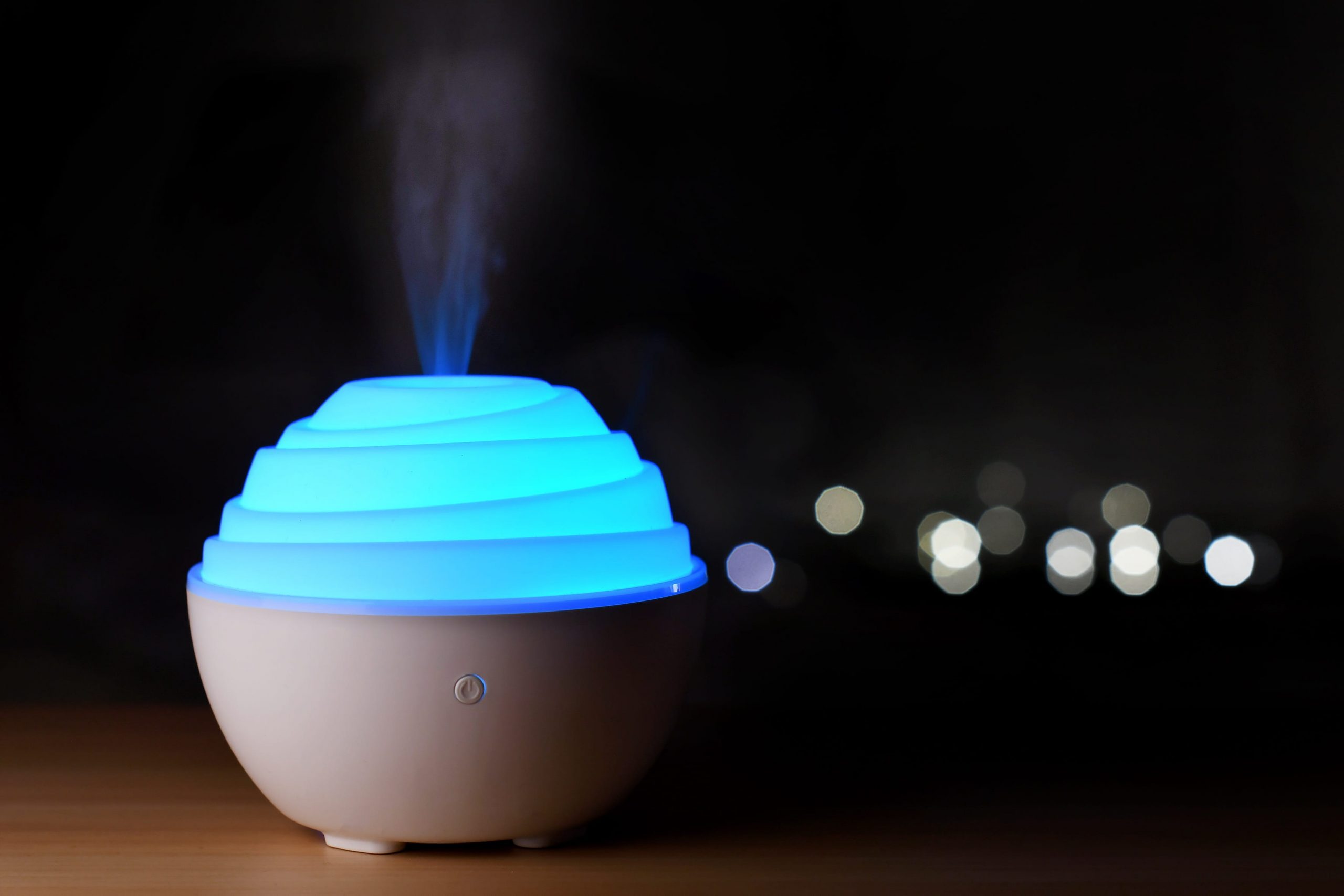
Case Study Conclusion: Cough That Won’t Quit
Inhaling the moist air from a humidifier or steamy shower can feel particularly good if you have a respiratory system infection, such as bronchitis. The moist air helps to loosen and thin mucus in the respiratory system, allowing you to breathe easier.
In the beginning of this chapter, you learned about Erica, who developed acute bronchitis after getting a cold. She had a worsening cough, a sore throat due to coughing, and chest congestion. She was also coughing up thick mucus.
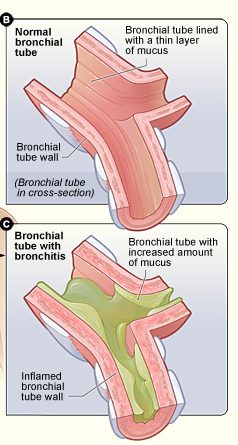
Acute bronchitis usually occurs after a cold or flu, usually due to the same viruses that cause cold or flu. Because bronchitis is not usually caused by bacteria (although it can be), in most cases, antibiotics are not an effective treatment.
Bronchitis affects the bronchial tubes, which, as you have learned, are air passages in the lower respiratory tract. The main bronchi branch off of the trachea and then branch into smaller bronchi, and then bronchioles. In bronchitis, the walls of the bronchi become inflamed, which makes them narrower. There is also excessive production of mucus in the bronchi, which further narrows the pathway where air can flow through. Figure 13.7.2, shows how bronchitis affects the bronchial tubes.
The treatment for most cases of bronchitis involves thinning and loosening the mucus so that it can be effectively coughed out of the airways. This can be done by drinking plenty of fluids, using humidifiers or steam, and — in some cases — using over-the-counter medications (such as expectorants). Dr. Choo recommended some of these treatments to Erica, and also warned against using cough suppressants. Cough suppressants work on the nervous system to suppress the cough reflex. When a patient has a “productive” cough (which means they are coughing up mucus), doctors generally advise them not to take cough suppressants, so that they can cough the mucus out of their bodies.
When Dr. Choo was examining Erica, she used a pulse oximeter to measure the oxygen level in her blood. Why did she do this? As you have learned, the bronchial tubes branch into bronchioles, which ultimately branch into the alveoli of the lungs. The alveoli are where gas exchange occurs between the air and the blood to take in oxygen and remove carbon dioxide and other wastes. By checking Erica’s blood oxygen level, Dr. Choo was making sure that her clogged airways were not impacting her level of much-needed oxygen.
Erica has acute bronchitis, but you may recall that chronic bronchitis was discussed earlier in this chapter (Section 13.5) as a term that describes the symptoms of chronic obstructive pulmonary disease (COPD). COPD is often due to tobacco smoking, and it causes damage to the walls of the alveoli. Acute bronchitis, on the other hand, typically occurs after a cold or flu, and involves inflammation and mucus build-up in the bronchial tubes. As implied by the difference in their names, chronic bronchitis is an ongoing, long-term condition, while acute bronchitis is likely to resolve relatively quickly with proper rest and treatment.
Erica uses e-cigarettes (vaping), so she is more likely to develop chronic respiratory conditions, such as COPD. As you have learned, smoking damages the respiratory system, along with many other systems of the body. Smoking and vaping increases the risk of respiratory infections, including bronchitis and flu, due to its damaging effects on the respiratory and immune systems. Dr. Choo strongly encouraged Erica to quit vaping, not only so that her acute bronchitis resolves, but so that she can avoid future infections and other negative health outcomes associated with vaping and smoking, including COPD and lung cancer.
As you have learned in this chapter, the respiratory system is critical to carry out the gas exchange necessary for life’s functions, and to protect the body from pathogens and other potentially harmful substances in the air. But this ability to interface with the outside air has a cost. The respiratory system is prone to infections, as well as damage and other negative effects from allergens, mold, air pollution, cigarette smoke and vaping. While exposure to most of these things cannot be avoided, not smoking is an important step you can take to protect this organ system — as well as many other systems of your body.
Chapter 13 Summary
In this chapter, you learned about the respiratory system. Specifically, you learned that:
- Respiration is the process in which oxygen moves from the outside air into the body, and carbon dioxide and other waste gases move from inside the body to the outside air. It involves two subsidiary processes: ventilation and gas exchange.
- The organs of the respiratory system form a continuous system of passages, called the respiratory tract. It has two major divisions: the upper respiratory tract and the lower respiratory tract.
-
- The upper respiratory tract includes the nasal cavity, pharynx, and larynx. All of these organs are involved in conduction, or the movement of air into and out of the body. Incoming air is also cleaned, humidified, and warmed as it passes through the upper respiratory tract. The larynx is also called the voice box, because it contains the vocal cords, which are needed to produce vocal sounds.
- The lower respiratory tract includes the trachea, bronchi and bronchioles, and the lungs. The trachea, bronchi, and bronchioles are involved in conduction. Gas exchange takes place only in the lungs, which are the largest organs of the respiratory tract. Lung tissue consists mainly of tiny air sacs called alveoli, which is where gas exchange takes place between air in the alveoli and the blood in capillaries surrounding them.
- The respiratory system protects itself from potentially harmful substances in the air by the mucociliary escalator. This includes mucus-producing cells, which trap particles and pathogens in incoming air. It also includes tiny hair-like cilia that continually move to sweep the mucus and trapped debris away from the lungs and toward the outside of the body.
- The level of carbon dioxide in the blood is monitored by cells in the brain. If the level becomes too high, it triggers a faster rate of breathing, which lowers the level to the normal range. The opposite occurs if the level becomes too low. The respiratory system exchanges gases with the outside air, but it needs the cardiovascular system to carry the gases to and from cells throughout the body.
- Breathing, or ventilation, is the two-step process of drawing air into the lungs (inhalation) and letting air out of the lungs (exhalation). Inhaling is an active process that results mainly from contraction of a muscle called the diaphragm. Exhaling is typically a passive process that occurs mainly due to the elasticity of the lungs when the diaphragm relaxes.
-
- Breathing is one of the few vital bodily functions that can be controlled consciously, as well as unconsciously. Conscious control of breathing is common in many activities, including swimming and singing. However, there are limits on the conscious control of breathing. If you try to hold your breath, for example, you will soon have an irrepressible urge to breathe.
- Unconscious breathing is controlled by respiratory centers in the medulla and pons of the brainstem. They respond to variations in blood pH by either increasing or decreasing the rate of breathing as needed to return the pH level to the normal range.
- Nasal breathing is generally considered to be superior to mouth breathing, because it does a better job of filtering, warming, and moistening incoming air. It also results in slower emptying of the lungs, which allows more oxygen to be extracted from the air.
- Gas exchange is the biological process through which gases are transferred across cell membranes to either enter or leave the blood. Gas exchange takes place continuously between the blood and cells throughout the body, and also between the blood and the air inside the lungs.
-
- Gas exchange in the lungs takes place in alveoli. The pulmonary artery carries deoxygenated blood from the heart to the lungs, where it travels through pulmonary capillaries, picking up oxygen and releasing carbon dioxide. The oxygenated blood then leaves the lungs through pulmonary veins.
- Gas exchange occurs by diffusion across cell membranes. Gas molecules naturally move down a concentration gradient from an area of higher concentration to an area of lower concentration. This is a passive process that requires no energy.
- Gas exchange by diffusion depends on the large surface area provided by the hundreds of millions of alveoli in the lungs. It also depends on a steep concentration gradient for oxygen and carbon dioxide. This gradient is maintained by continuous blood flow and constant breathing.
- Asthma is a chronic inflammatory disease of the airways in the lungs, in which the airways periodically become inflamed. This causes swelling and narrowing of the airways, often with excessive mucus production, leading to difficulty breathing and other symptoms. Asthma is thought to be caused by a combination of genetic and environmental factors. Asthma attacks are triggered by allergens, air pollution, or other factors.
- Pneumonia is a common inflammatory disease of the respiratory tract in which inflammation affects primarily the alveoli, which become filled with fluid that inhibits gas exchange. Most cases of pneumonia are caused by viral or bacterial infections. Vaccines are available to prevent pneumonia. Treatment often includes prescription antibiotics.
- Chronic obstructive pulmonary disease (COPD) is a lung disease characterized by chronic poor airflow, which causes shortness of breath and a productive cough. It is caused most often by tobacco smoking, which leads to breakdown of connective tissues in the lungs. Alveoli are reduced in number and elasticity, making it impossible to fully exhale air from the lungs. There is no cure for COPD, but stopping smoking may reduce the rate at which COPD worsens.
- Lung cancer is a malignant tumor characterized by uncontrolled cell growth in tissues of the lung. It results from accumulated DNA damage, most often caused by tobacco smoking. Lung cancer is typically diagnosed late, so most cases cannot be cured. It may be treated with surgery, chemotherapy, and/or radiation therapy.
- Smoking is the single greatest cause of preventable death worldwide. It has adverse effects on just about every body system and organ. Tobacco smoke affects not only smokers, but also non-smokers who are exposed to secondhand smoke. The nicotine in tobacco is highly addictive, making it very difficult to quit smoking.
-
- A major health risk of smoking is lung cancer. Smoking also increases the risk of many other types of cancer. Tobacco smoke contains dozens of chemicals that are known carcinogens.
- Smoking is the primary cause of COPD. Chemicals — such as carbon monoxide and cyanide in tobacco smoke — reduce the elasticity of alveoli so the lungs can no longer fully exhale air.
- Smoking and/or vaping damages the cardiovascular system and increases the risk of high blood pressure, blood clots, heart attack, and stroke. Smoking also has a negative impact on blood lipid levels.
- A wide diversity of additional adverse health effects — such as erectile dysfunction, female infertility, and slow wound healing — are attributable to smoking.
As you have learned, the respiratory system brings in oxygen to the body and removes waste gases to the atmosphere — but these molecules wouldn’t get to where they need to go without the cardiovascular system to transport them via the bloodstream. Read the next chapter to learn about how the cardiovascular system carries out these critical functions.
Chapter 13 Review
-
- Describe the relationship between the bronchi, secondary bronchi, tertiary bronchi, and bronchioles.
- Deoxygenated and oxygenated blood both travel to the lungs. Describe what happens to that blood when it gets to the lungs.
- Explain the difference between ventilation and gas exchange.
- Which way do oxygen and carbon dioxide flow during gas exchange in the lungs, and why? Which way do oxygen and carbon dioxide flow during gas exchange between the blood and the body’s cells, and why?
- Why does the body require oxygen, and why does it emit carbon dioxide as a waste product?
- What do coughing and sneezing have in common?
- COPD can cause too much carbon dioxide in the blood. Answer the following questions about this:
- How does COPD cause there to be too much carbon dioxide in the blood?
- What does this do to the blood pH?
- How does the body respond to this change in blood pH?
- What are three different types of things that can enter the respiratory system and cause illness or injury? Describe the negative health effects of each in your answer.
- Where are the respiratory centers of the brain located? What is the main function of the respiratory centers of the brain?
- Smoking increases the risk of getting influenza, commonly known as the flu. Explain why this could lead to a greater risk of pneumonia.
- If a person has a gene that caused them to get asthma, could changes to their environment (such as more frequent cleaning) help their asthma? Why or why not?
- Explain why nasal breathing generally stops particles from entering the body at an earlier stage than mouth breathing does.
Attributions
Figure 13.7.1
Tags: Essential Oils Aroma Diffuser Diffuse Led by asundermeier on Pixabay is used under the Pixabay License (https://unsplash.com/license).
Figure 13.7.2
Bronchitis by National Heart Lung and Blood Institute on Wikimedia Commons is in the public domain (https://en.wikipedia.org/wiki/Public_domain).
Created by CK-12 Foundation/Adapted by Christine Miller
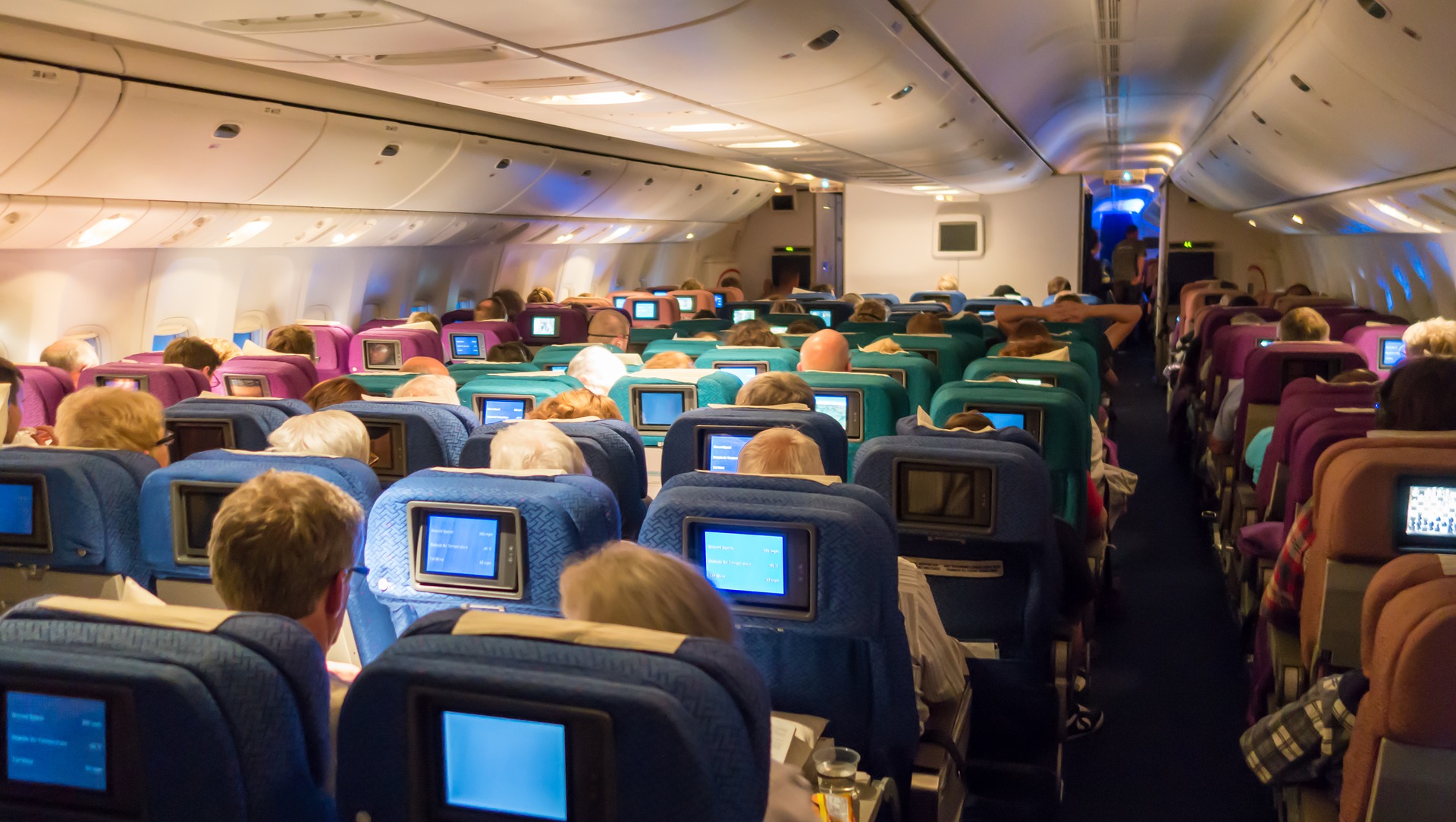
Case Study: Flight Risk
Nineteen-year-old Malcolm is about to take his first plane flight. Shortly after he boards the plane and sits down, a man in his late sixties sits next to him in the aisle seat. About half an hour after the plane takes off, the pilot announces that she is turning the seat belt light off, and that it is safe to move around the cabin.
The man in the aisle seat — who has introduced himself to Malcolm as Willie — immediately unbuckles his seat belt and paces up and down the aisle a few times before returning to his seat. After about 45 minutes, Willie gets up again, walks some more, then sits back down and does some foot and leg exercises. After the third time Willie gets up and paces the aisles, Malcolm asks him whether he is walking so much to accumulate steps on a pedometer or fitness tracking device. Willie laughs and says no. He is actually trying to do something even more important for his health — prevent a blood clot from forming in his legs.
Willie explains that he has a chronic condition: heart failure. Although it sounds scary, his condition is currently well-managed, and he is able to lead a relatively normal lifestyle. However, it does put him at risk of developing other serious health conditions, such as deep vein thrombosis (DVT), which is when a blood clot occurs in the deep veins, usually in the legs. Air travel — and other situations where a person has to sit for a long period of time — increases the risk of DVT. Willie’s doctor said that he is healthy enough to fly, but that he should walk frequently and do leg exercises to help avoid a blood clot.
As you read this chapter, you will learn about the heart, blood vessels, and blood that make up the cardiovascular system, as well as disorders of the cardiovascular system, such as heart failure. At the end of the chapter you will learn more about why DVT occurs, why Willie has to take extra precautions when he flies, and what can be done to lower the risk of DVT and its potentially deadly consequences.
Chapter Overview: Cardiovascular System
In this chapter, you will learn about the cardiovascular system, which transports substances throughout the body. Specifically, you will learn about:
- The major components of the cardiovascular system: the heart, blood vessels, and blood.
- The functions of the cardiovascular system, including transporting needed substances (such as oxygen and nutrients) to the cells of the body, and picking up waste products.
- How blood is oxygenated through the pulmonary circulation, which transports blood between the heart and lungs.
- How blood is circulated throughout the body through the systemic circulation.
- The components of blood — including plasma, red blood cells, white blood cells, and platelets — and their specific functions.
- Types of blood vessels — including arteries, veins, and capillaries — and their functions, similarities, and differences.
- The structure of the heart, how it pumps blood, and how contractions of the heart are controlled.
- What blood pressure is and how it is regulated.
- Blood disorders, including anemia, HIV, and leukemia.
- Cardiovascular diseases (including heart attack, stroke, and angina), and the risk factors and precursors — such as high blood pressure and atherosclerosis — that contribute to them.
As you read the chapter, think about the following questions:
- What is heart failure?Why do you think it increases the risk of DVT?
- What is a blood clot? What are possible health consequences of blood clots?
- Why do you think sitting for long periods of time increases the risk of DVT? Why does walking and exercising the legs help reduce this risk?
Attribution
Figure 14.1.1
aircraft-1583871_1920 [photo] by olivier89 from Pixabay is used under the Pixabay License (https://pixabay.com/de/service/license/).
Diagram shows examples of the shapes of different types of fatty acids. Saturated fatty acids form long straight chains. Monounsaturated fatty acids have a slight curve and saturated fatty acids can have multiple curves or bends.
Case Study: Our Invisible Inhabitants
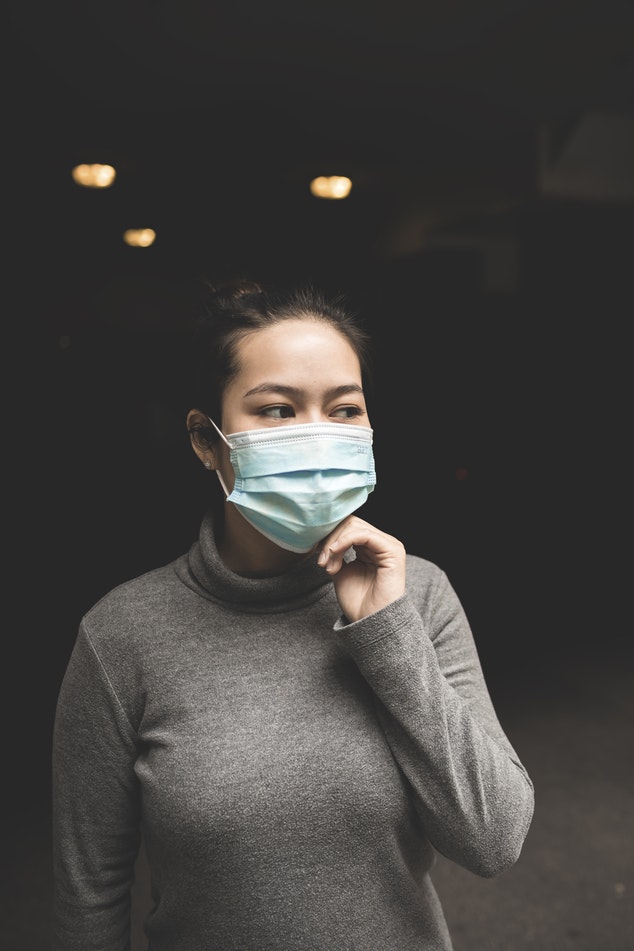
Lanying is suffering from a fever, body aches, and a painful sore throat that feels worse when she swallows. She visits her doctor, who examines her and performs a throat culture. When the results come back, he tells her that she has strep throat, which is caused by the bacteria Streptococcus pyogenes. He prescribes an antibiotic that will either kill the bacteria or stop it from reproducing, and advises her to take the full course of the treatment even if she is feeling better earlier. Stopping early can cause an increase in bacteria that are resistant to antibiotics.
Lanying takes the antibiotic as prescribed. Toward the end of the course, her throat is feeling much better — but she can’t say the same for other parts of her body! She has developed diarrhea and an itchy vaginal yeast infection. She calls her doctor, who suspects that the antibiotic treatment has caused both the digestive distress and the yeast infection. He explains that our bodies are home to many different kinds of microorganisms, some of which are actually beneficial to us because they help us digest our food and minimize the population of harmful microorganisms. When we take an antibiotic, many of these “good” bacteria are killed along with the “bad,” disease-causing bacteria, which can result in diarrhea and yeast infections.
Lanying's doctor prescribes an antifungal medication for her yeast infection. He also recommends that she eat yogurt with live cultures, which will help replace the beneficial bacteria in her gut. Our bodies contain a delicate balance of inhabitants that are invisible without a microscope, and changes in that balance can cause unpleasant health effects.
What Is Human Biology?
As you read the rest of this book, you'll learn more amazing facts about the human organism, and you'll get a better sense of how biology relates to your health. Human biology is the scientific study of the human species, which includes the fascinating story of human evolution and a detailed account of our genetics, anatomy, physiology, and ecology. In short, the study focuses on how we got here, how we function, and the role we play in the natural world. This helps us to better understand human health, because we can learn how to stay healthy and how diseases and injuries can be treated. Human biology should be of personal interest to you to the extent that it can benefit your own health, as well as the health of your friends and family. This branch of science also has broader implications for society and the human species as a whole.
Chapter Overview: Living Organisms and Human Biology
In the rest of this chapter, you'll learn about the traits shared by all living things, the basic principles that underlie all of biology, the vast diversity of living organisms, what it means to be human, and our place in the animal kingdom. Specifically, you'll learn:
- The seven traits shared by all living things: homeostasis, or the maintenance of a more-or-less constant internal environment; multiple levels of organization consisting of one or more cells; the use of energy and metabolism; the ability to grow and develop; the ability to evolve adaptations to the environment; the ability to detect and respond to environmental stimuli; and the ability to reproduce.
- The basic principles that unify all fields of biology, including gene theory, homeostasis, and evolutionary theory.
- The diversity of life (including the different kinds of biodiversity), the definition of a species, the classification and naming systems for living organisms, and how evolutionary relationships can be represented through diagrams, such as phylogenetic trees.
- How the human species is classified and how we've evolved from our close relatives and ancestors.
- The physical traits and social behaviors that humans share with other primates.
As you read this chapter, consider the following questions about Lanying's situation:
- What do single-celled organisms (such as the bacteria and yeast living in and on Lanying) have in common with humans?
- How are bacteria, yeast, and humans classified?
- How do the concepts of homeostasis and biodiversity apply to Lanying’s situation?
- Why can stopping antibiotics early cause the development of antibiotic-resistant bacteria?
Attribution
Figure 2.1.1
Photo (face mask) by Michael Amadeus, on Unsplash is used under the Unsplash license (https://unsplash.com/license).
Reference
Mayo Clinic Staff (n.d.). Strep throat [online article]. MayoClinic.org. https://www.mayoclinic.org/diseases-conditions/strep-throat/symptoms-causes/syc-20350338
Created by CK-12/Adapted by Christine Miller
Case Study: Our Invisible Inhabitants

Lanying is suffering from a fever, body aches, and a painful sore throat that feels worse when she swallows. She visits her doctor, who examines her and performs a throat culture. When the results come back, he tells her that she has strep throat, which is caused by the bacteria Streptococcus pyogenes. He prescribes an antibiotic that will either kill the bacteria or stop it from reproducing, and advises her to take the full course of the treatment even if she is feeling better earlier. Stopping early can cause an increase in bacteria that are resistant to antibiotics.
Lanying takes the antibiotic as prescribed. Toward the end of the course, her throat is feeling much better — but she can’t say the same for other parts of her body! She has developed diarrhea and an itchy vaginal yeast infection. She calls her doctor, who suspects that the antibiotic treatment has caused both the digestive distress and the yeast infection. He explains that our bodies are home to many different kinds of microorganisms, some of which are actually beneficial to us because they help us digest our food and minimize the population of harmful microorganisms. When we take an antibiotic, many of these “good” bacteria are killed along with the “bad,” disease-causing bacteria, which can result in diarrhea and yeast infections.
Lanying's doctor prescribes an antifungal medication for her yeast infection. He also recommends that she eat yogurt with live cultures, which will help replace the beneficial bacteria in her gut. Our bodies contain a delicate balance of inhabitants that are invisible without a microscope, and changes in that balance can cause unpleasant health effects.
What Is Human Biology?
As you read the rest of this book, you'll learn more amazing facts about the human organism, and you'll get a better sense of how biology relates to your health. Human biology is the scientific study of the human species, which includes the fascinating story of human evolution and a detailed account of our genetics, anatomy, physiology, and ecology. In short, the study focuses on how we got here, how we function, and the role we play in the natural world. This helps us to better understand human health, because we can learn how to stay healthy and how diseases and injuries can be treated. Human biology should be of personal interest to you to the extent that it can benefit your own health, as well as the health of your friends and family. This branch of science also has broader implications for society and the human species as a whole.
Chapter Overview: Living Organisms and Human Biology
In the rest of this chapter, you'll learn about the traits shared by all living things, the basic principles that underlie all of biology, the vast diversity of living organisms, what it means to be human, and our place in the animal kingdom. Specifically, you'll learn:
- The seven traits shared by all living things: homeostasis, or the maintenance of a more-or-less constant internal environment; multiple levels of organization consisting of one or more cells; the use of energy and metabolism; the ability to grow and develop; the ability to evolve adaptations to the environment; the ability to detect and respond to environmental stimuli; and the ability to reproduce.
- The basic principles that unify all fields of biology, including gene theory, homeostasis, and evolutionary theory.
- The diversity of life (including the different kinds of biodiversity), the definition of a species, the classification and naming systems for living organisms, and how evolutionary relationships can be represented through diagrams, such as phylogenetic trees.
- How the human species is classified and how we've evolved from our close relatives and ancestors.
- The physical traits and social behaviors that humans share with other primates.
As you read this chapter, consider the following questions about Lanying's situation:
- What do single-celled organisms (such as the bacteria and yeast living in and on Lanying) have in common with humans?
- How are bacteria, yeast, and humans classified?
- How do the concepts of homeostasis and biodiversity apply to Lanying’s situation?
- Why can stopping antibiotics early cause the development of antibiotic-resistant bacteria?
Attribution
Figure 2.1.1
Photo (face mask) by Michael Amadeus, on Unsplash is used under the Unsplash license (https://unsplash.com/license).
Reference
Mayo Clinic Staff (n.d.). Strep throat [online article]. MayoClinic.org. https://www.mayoclinic.org/diseases-conditions/strep-throat/symptoms-causes/syc-20350338
Created by CK-12/Adapted by Christine Miller
The Thinker
![Auguste Rodin [CC0] The Thinker (French: Le Penseur) is a bronze sculpture by Auguste Rodin, usually placed on a stone pedestal. The work shows a nude male figure of over life-size sitting on a rock with his chin resting on one hand as though deep in thought, often used as an image to represent philosophy.](https://pressbooks.ccconline.org/acchumanbio/wp-content/uploads/sites/152/2019/06/The-thinker-2.jpg)
You've probably seen this famous statue created by the French sculptor Auguste Rodin. Rodin's skill as a sculptor is especially evident here because the statue — which is made of bronze — looks so lifelike. How does a bronze statue differ from a living, breathing human being or other living organism? What is life? What does it mean to be alive? Science has answers to these questions.
Characteristics of Living Things
To be classified as a living thing, most scientists agree that an object must have all seven of the traits listed below. Humans share these characteristics with other living things.
- Homeostasis
- Organization
- Metabolism
- Growth
- Adaptation
- Response to stimuli
- Reproduction
Homeostasis
All living things are able to maintain a more-or-less constant internal environment. Regardless of the conditions around them, they can keep things relatively stable on the inside. The condition in which a system is maintained in a more-or-less steady state is called homeostasis. Human beings, for example, maintain a stable internal body temperature. If you go outside when the air temperature is below freezing, your body doesn't freeze. Instead, by shivering and other means, it maintains a stable internal temperature.
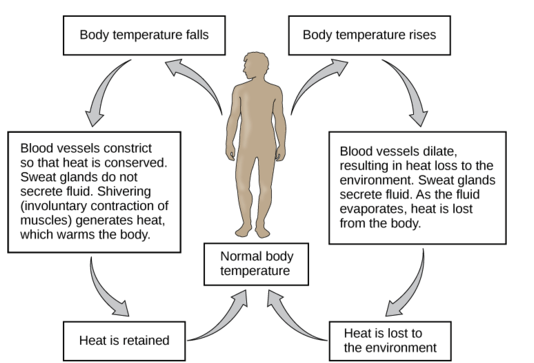
Organization
Living things have multiple levels of organization. Their molecules are organized into one or more cells. A cell is the basic unit of the structure and function of living things. Cells are the building blocks of living organisms. An average adult human being, for example, consists of trillions of cells. Living things may appear very different from one another on the outside, but their cells are very similar. Compare the human cells and onion cells in Figures 2.2.3 and 2.2.4. What similarities do you see?
![Joseph Elsbernd [CC BY-SA 2.0 (https://creativecommons.org/licenses/by-sa/2.0)] Shows the image through a microscope of human cheek cells. The cells are oval in shape and light blue, with a darker blue spot close to the centre. The light blue shows the cell membrane and cytoplasm and the darker blue shows the nucleus of the cell.](https://pressbooks.ccconline.org/acchumanbio/wp-content/uploads/sites/152/2023/10/Cheek-Cells-2.jpg)
![kaibara87 [CC BY 2.0 (https://creativecommons.org/licenses/by/2.0)] Shows an image through a microscope of onion cells. The cells are packed together and are rectangular in shape. Their cell walls and nuclei are stained a darker blue and the cytoplasm is whitish.](https://pressbooks.ccconline.org/acchumanbio/wp-content/uploads/sites/152/2023/10/Onion-Cells-2.jpg)
Metabolism
All living things can use energy. They require energy to maintain internal conditions (homeostasis), to grow, and to execute other processes. Living cells use the "machinery" of metabolism, which is the building up and breaking down of chemical compounds. Living things can transform energy by building up large molecules from smaller ones. This form of metabolism is called anabolism. Living things can also break down, or decompose, large organic molecules into smaller ones. This form of metabolism is called catabolism.
Consider weight lifters who eat high-protein diets. A protein is a large molecule made up of several small amino acids. When we eat proteins, our digestive system breaks them down into amino acids (catabolism), so that they are small enough to be absorbed by the digestive system and into the blood. From there, amino acids are transported to muscles, where they are converted back to proteins (anabolism).

Growth
All living things have the capacity for growth. Growth is an increase in size that occurs when there is a higher rate of anabolism than catabolism. A human infant, for example, has changed dramatically in size by the time it reaches adulthood, as is apparent from the image below. In what other ways do we change as we grow from infancy to adulthood?
A human infant has a lot of growing to do before adulthood.
Adaptations and Evolution
An adaptation is a characteristic that helps living things survive and reproduce in a given environment. It comes about because living things have the ability to change over time in response to the environment. A change in the characteristics of living things over time is called evolution. It develops in a population of organisms through random genetic mutations and natural selection.
Response to Stimuli
All living things detect changes in their environment and respond to them. These stimuli can be internal or external, and the response can take many forms, from the movement of a unicellular organism in response to external chemicals (called chemotaxis) to complex reactions involving all the senses of a multicellular organism. A response is often expressed by motion; for example, the leaves of a plant turning toward the sun (called phototropism).
Click through the images below: the venus fly trap, the cat, and the flower are all showing response to a stimuli.
Figure 2.2.6 Examples of responses to environmental stimuli.
Reproduction
All living things are capable of reproduction, the process by which living things give rise to offspring. Reproduction may be as simple as a single cell dividing to form two daughter cells, which is how bacteria reproduce. Reproduction in human beings and many other organisms, of course, is much more complicated. Nonetheless, whether a living thing is a human being or a bacterium, it is normally capable of reproduction.
Feature: Myth vs. Reality
Myth: Viruses are living things.
Reality: The traditional scientific view of viruses is that they originate from bits of DNA or RNA shed from the cells of living things, but that they are not living things themselves. Scientists have long argued that viruses are not living things because they do not exhibit most of the defining traits of living organisms. A single virus, called a virion, consists of a set of genes (DNA or RNA) inside a protective protein coat, called a capsid. Viruses have organization, but they are not cells, and they do not possess the cellular "machinery" that living things use to carry out life processes. As a result, viruses cannot undertake metabolism, maintain homeostasis, or grow.
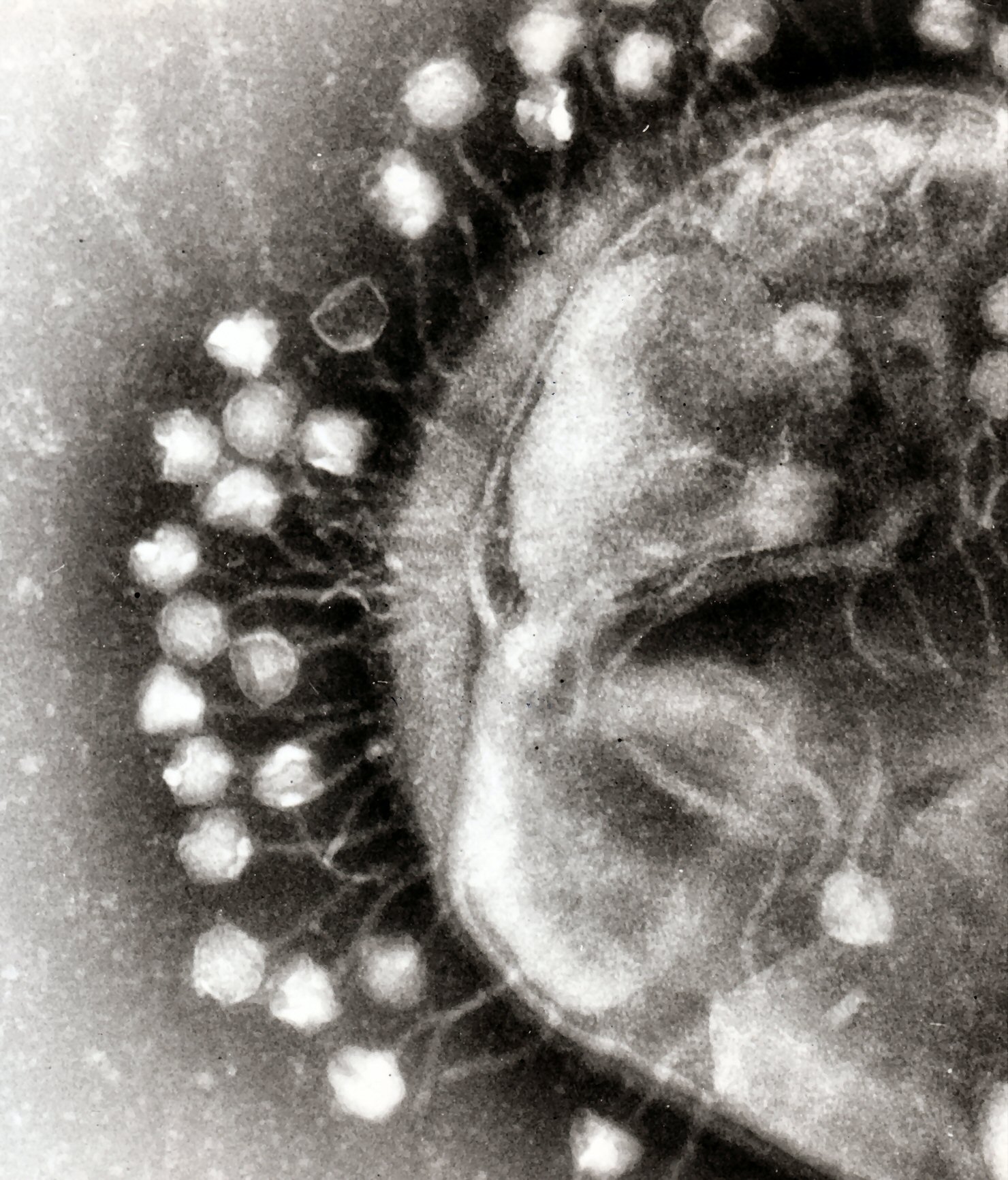
They do not seem to respond to their environment, and they can reproduce only by invading and using "tools" inside host cells to produce more virions. The only traits viruses seem to share with living things is the ability to evolve adaptations to their environment. In fact, some viruses evolve so quickly that it is difficult to design drugs and vaccines against them! That's why maintaining protection from the viral disease influenza, for example, requires a new flu vaccine each year.
Within the last decade, new discoveries in virology (the study of viruses) suggest that this traditional view about viruses may be incorrect, and that the "myth" that viruses are living things may be the reality. Researchers have discovered giant viruses that contain more genes than cellular life forms, such as bacteria. Some of the genes code for proteins needed to build new viruses, which suggests that these giant viruses may be able — or were once able — to reproduce without a host cell. Some of the strongest evidence that viruses are living things comes from studies of their proteins, which show that viruses and cellular life share a common ancestor in the distant past. Viruses may have once existed as primitive cells, but at some point they lost their cellular nature and became modern viruses that require host cells to reproduce. This idea is not so far-fetched when you consider that many other species require a host to complete their life cycle.
2.2 Summary
- To be classified as a living thing, most scientists agree that an object must exhibit seven characteristics. Humans share these traits with all other living things.
- All living things:
- Can maintain a more-or-less constant internal environment, which is called homeostasis.
- Have multiple levels of organization and consist of one or more cells.
- Can use energy and are capable of metabolism.
- Grow and develop.
- Can evolve adaptations to their environment.
- Can detect and respond to environmental stimuli.
- Are capable of reproduction, which is the process by which living things give rise to offspring.
2.2 Review Questions
- Identify the seven traits that most scientists agree are shared by all living things.
- What is homeostasis? What is one way humans fulfill this criterion of living things?
- Define reproduction and describe two different examples.
- Assume that you found an object that looks like a dead twig. You wonder if it might be a stick insect. How could you ethically determine if it is a living thing?
- Describe viruses and which traits they do and do not share with living things. Do you think viruses should be considered living things? Why or why not?
- People who are biologically unable to reproduce are certainly still considered alive. Discuss why this situation does not invalidate the criteria that living things must be capable of reproduction.
- What are the two types of metabolism described here. What are their differences?
- What are some similarities between the cells of different organisms? If you are not familiar with the specifics of cells, simply describe the similarities you see in the pictures above.
- What are two processes in a living thing that use energy?
- Give an example of a response to stimuli in humans.
- Do unicellular organisms (such as bacteria) have an internal environment that they maintain through homeostasis? Why or why not?
- Evolution occurs through natural ____________ .
- If alien life is found on other planets, do you think the aliens will have cells? Discuss your answer.
- Movement in response to an external chemical is called ___________, while movement towards light is called ___________ .
2.2 Explore More
https://www.youtube.com/watch?v=cQPVXrV0GNA&t=354s
Characteristics of Life, Ameoba Sisters, 2017.
Attributions
Figure 2.2.1
The Thinker MET 131262, by Auguste Rodin, 1910, from the Metropolitan Museum of Art, is in the public domain (https://en.wikipedia.org/wiki/Public_domain).
Figure 2.2.2
Homeostasis: Figure 4, by OpenStax College, Biology is used under a CC BY 4.0 (https://creativecommons.org/licenses/by/4.0) license. Download for free at http://cnx.org/contents/04fdb865-17a1-43d8-bb33-36f821ddd119@7.
Figure 2.2.3
Human cheek cells, by Joseph Elsbernd, 2012, on Flickr, is used under a CC BY-SA 2.0 (https://creativecommons.org/licenses/by-sa/2.0/) license.
Figure 2.2.4
Onion cells 2, by Umberto Salvagnin, 2009, on Flickr, is used under a CC BY 2.0 (https://creativecommons.org/licenses/by/2.0/) license.
Figure 2.2.5
Photo (family) by Jakob Owens on Unsplash is used under the Unsplash License (https://unsplash.com/license).
Figure 2.2.6
- Trap of Dionaea muscipula by che on Wikimedia Commons is used under a CC BY-SA 2.5 (https://creativecommons.org/licenses/by-sa/2.5/deed.en) license.
- Plants leaning towards the sunlight from Pxhere is used under a CC0 1.0 universal
public domain dedication license (https://creativecommons.org/publicdomain/zero/1.0/). - Surprised young cat by Watchduck (a.k.a. Tilman Piesk) on Wikimedia Commons is used under a CC BY 3.0 (https://creativecommons.org/licenses/by/3.0) license.
Figure 2.2.7
Bacteriophages, by Dr. Graham Beards, is used under a CC BY-SA 3.0 (https://creativecommons.org/licenses/by-sa/3.0) license.
References
Ameoba Sisters. (2017, October 26). Characteristics of life. YouTube. https://www.youtube.com/watch?v=cQPVXrV0GNA&feature=youtu.be
OpenStax. (2016, March 23). Figure 4 The body is able to regulate temperature in response to signals from the nervous system. In OpenStax, Biology (Section 33.3). OpenStax CNX. http://cnx.org/contents/185cbf87-c72e-48f5-b51e-f14f21b5eabd@10.8.
Wikipedia contributors. (2020, June 14). Adaptation. Wikipedia. https://en.wikipedia.org/w/index.php?title=Adaptation&oldid=962556016
Wikipedia contributors. (2020, June 21). Auguste Rodin. Wikipedia. https://en.wikipedia.org/w/index.php?title=Auguste_Rodin&oldid=963668399
Wikipedia contributors. (2020, June 22). Chemotaxis. Wikipedia. https://en.wikipedia.org/w/index.php?title=Chemotaxis&oldid=963884872
Wikipedia contributors. (2020, June 22). Evolution. Wikipedia. https://en.wikipedia.org/w/index.php?title=Evolution&oldid=963929880
Wikipedia contributors. (2020, June 20). Phototropism. Wikipedia. https://en.wikipedia.org/w/index.php?title=Phototropism&oldid=963567791
Wikipedia contributors. (2020, June 22). Virus. Wikipedia. https://en.wikipedia.org/w/index.php?title=Virus&oldid=963829311
Why Are Humans Such Sweaty Animals?
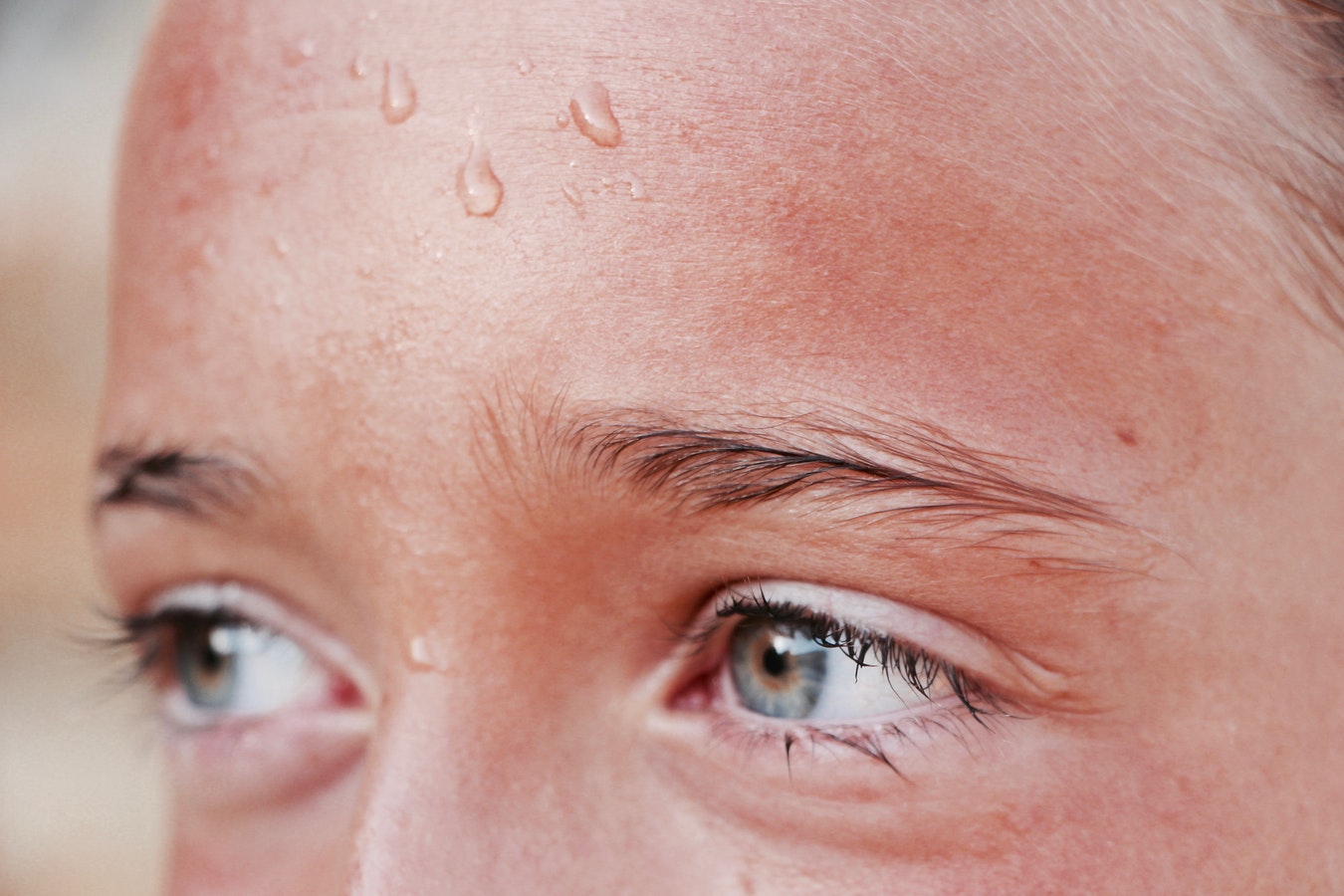
Combine exercise and a hot day, and you get sweat — and lots of it. Sweating is one of the adaptations humans have evolved to maintain homeostasis, or a constant internal environment. When sweat evaporates from the skin, it uses up some of the excess heat energy on the skin, thus helping to reduce the body's temperature. Humans are among the sweatiest of all species, with a fine-tuned ability to maintain a steady internal temperature, even at very high outside temperatures.
Unifying Principles of Biology
All living things have mechanisms for homeostasis. Homeostasis is one of four basic principles or theories that explain the structure and function of all species (including our own). Whether biologists are interested in ancient life, the life of bacteria, or how humans could live on Mars, they base their understanding of biology on these unifying principles:
Cell Theory
According to cell theory, all living things are made of cells, and living cells come only from other living cells. Each living thing begins life as a single cell. Some living things, including bacteria, remain single-celled. Other living things, including plants and animals, grow and develop into many cells. Your own body is made up of an amazing 100 trillion cells. But even you — like all other living things — began life as a single cell.
Watch this TED-Ed video about the origin of cell theory:
https://www.youtube.com/watch?v=4OpBylwH9DU
The Wacky History of Cell Theory - Lauren Royal-Woods, TED-Ed, 2012
Gene Theory
Gene theory is the idea that the characteristics of living things are controlled by genes, which are passed from parents to their offspring. Genes are located on larger structures called chromosomes. Chromosomes are found inside every cell, and they consist of molecules of DNA (deoxyribonucleic acid). Those molecules of DNA are encoded with instructions that "tell" cells how to behave.
Homeostasis
Homeostasis, or the condition in which a system is maintained in a more-or-less steady state, is a characteristic of individual living things, like the human ability to sweat. Homeostasis also applies to the entire biosphere, wherever life is found on Earth. Consider the concentration of oxygen in Earth's atmosphere. Oxygen makes up 21 per cent of the atmosphere, and this concentration is fairly constant. What maintains this homeostasis in the atmosphere? The answer is living things.
Most living things need oxygen to survive, so they remove oxygen from the air. On the other hand, many living things, including plants, give off oxygen when they convert carbon dioxide and water to food in the process of photosynthesis. These two processes balance out so the air maintains a constant level of oxygen.
Evolutionary Theory

Evolution is a change in the characteristics of populations of living things over time. Evolution can occur by a process called natural selection, which results from random genetic mutations in a population. If these mutations lead to changes that allow the living things to better survive, then their chances of surviving and reproducing in a given environment increase. They will then pass more genes to the next generation. Over many generations, this can lead to major changes in the characteristics of those living things. Evolution explains how living things are changing today, as well as how modern living things descended from ancient life forms that no longer exist on Earth.
Traits that help living things survive and reproduce in a given environment are called adaptations. You can see an obvious adaptation in the image below. The chameleon is famous for its ability to change its colour to match its background as camouflage. Using camouflage, the chameleon can hide in plain sight.
Feature: Myth vs. Reality
Misconceptions about evolution are common. They include the following myths:
Myth |
Reality |
| "Evolution is "just" a theory or educated guess." | Scientists accept evolutionary theory as the best explanation for the diversity of life on Earth because of the large body of scientific evidence supporting it. Like any scientific theory, evolution is a broad, evidence-supported explanation for multiple phenomena. |
| "The theory of evolution explains how life on Earth began." | The theory of evolution explains how life changed on Earth after it began. |
| "The theory of evolution means that humans evolved from apes like those in zoos." | Humans and modern apes both evolved from a common ape-like ancestor millions of years ago. |
2.3 Summary
- Four basic principles or theories unify all fields of biology: cell theory, gene theory, homeostasis, and evolutionary theory.
- According to cell theory, all living things are made of cells and come from other living cells.
- Gene theory states that the characteristics of living things are controlled by genes that pass from parents to offspring.
- All living things strive to maintain internal balance, or homeostasis.
- The characteristics of populations of living things change over time through the process of micro-evolution as organisms acquire adaptations, or traits that better suit them to a given environment.
Use the flashcards below to review the four principles:
2.3 Review Questions
-
- How does sweating help the human body maintain homeostasis?
- Explain cell theory and gene theory.
- Describe an example of homeostasis in the atmosphere.
- Describe how you can apply the concepts of evolution,natural selection, adaptation, and homeostasis to the human ability to sweat.
- Which of the four unifying principles of biology is primarily concerned with:
- how DNA is passed down to offspring?
- how internal balance is maintained?
- _____________ are located on ______________.
- chromosomes; genes
- genes;chromosomes
- genes; traits
- none of the above
- Define an adaptation and give one example.
- Explain how gene theory and evolutionary theory relate to each other.
- Does evolution by natural selection occur within one generation? Why or why not?
- Explain why you think chameleons evolved the ability to change their colour to match their background, as well as how natural selection may have acted on the ancestors of chameleons to produce this adaptation.
2.3 Explore More
https://www.youtube.com/watch?v=Wg5DBH6uMCw&feature=emb_logo
Myths and misconceptions about evolution - Alex Gendler, TEDEd, 2013
Attributions
Figure 2.3.1
Photo(perspiration), by Hans Reniers on Unsplash. is used under the Unsplash license (https://unsplash.com/license).
Figure 2.3.2
Mediterranean Chameleon Reptile Lizard, by user:1588877 on Pixabay, is used under the Pixabay license (https://pixabay.com/de/service/license/).
References
TED-Ed. (2012, June 4). The wacky history of cell theory - Lauren Royal-Woods. YouTube. https://www.youtube.com/watch?v=4OpBylwH9DU&feature=youtu.be
TED-Ed. (2013, July 8). Myths and misconceptions about evolution - Alex Gendler. YouTube. https://www.youtube.com/watch?v=mZt1Gn0R22Q&t=10s
The Thinker
![Auguste Rodin [CC0] The Thinker (French: Le Penseur) is a bronze sculpture by Auguste Rodin, usually placed on a stone pedestal. The work shows a nude male figure of over life-size sitting on a rock with his chin resting on one hand as though deep in thought, often used as an image to represent philosophy.](https://pressbooks.ccconline.org/acchumanbio/wp-content/uploads/sites/152/2019/06/The-thinker-2.jpg)
You've probably seen this famous statue created by the French sculptor Auguste Rodin. Rodin's skill as a sculptor is especially evident here because the statue — which is made of bronze — looks so lifelike. How does a bronze statue differ from a living, breathing human being or other living organism? What is life? What does it mean to be alive? Science has answers to these questions.
Characteristics of Living Things
To be classified as a living thing, most scientists agree that an object must have all seven of the traits listed below. Humans share these characteristics with other living things.
- Homeostasis
- Organization
- Metabolism
- Growth
- Adaptation
- Response to stimuli
- Reproduction
Homeostasis
All living things are able to maintain a more-or-less constant internal environment. Regardless of the conditions around them, they can keep things relatively stable on the inside. The condition in which a system is maintained in a more-or-less steady state is called homeostasis. Human beings, for example, maintain a stable internal body temperature. If you go outside when the air temperature is below freezing, your body doesn't freeze. Instead, by shivering and other means, it maintains a stable internal temperature.

Organization
Living things have multiple levels of organization. Their molecules are organized into one or more cells. A cell is the basic unit of the structure and function of living things. Cells are the building blocks of living organisms. An average adult human being, for example, consists of trillions of cells. Living things may appear very different from one another on the outside, but their cells are very similar. Compare the human cells and onion cells in Figures 2.2.3 and 2.2.4. What similarities do you see?
![Joseph Elsbernd [CC BY-SA 2.0 (https://creativecommons.org/licenses/by-sa/2.0)] Shows the image through a microscope of human cheek cells. The cells are oval in shape and light blue, with a darker blue spot close to the centre. The light blue shows the cell membrane and cytoplasm and the darker blue shows the nucleus of the cell.](https://pressbooks.ccconline.org/acchumanbio/wp-content/uploads/sites/152/2023/10/Cheek-Cells-2.jpg)
![kaibara87 [CC BY 2.0 (https://creativecommons.org/licenses/by/2.0)] Shows an image through a microscope of onion cells. The cells are packed together and are rectangular in shape. Their cell walls and nuclei are stained a darker blue and the cytoplasm is whitish.](https://pressbooks.ccconline.org/acchumanbio/wp-content/uploads/sites/152/2023/10/Onion-Cells-2.jpg)
Metabolism
All living things can use energy. They require energy to maintain internal conditions (homeostasis), to grow, and to execute other processes. Living cells use the "machinery" of metabolism, which is the building up and breaking down of chemical compounds. Living things can transform energy by building up large molecules from smaller ones. This form of metabolism is called anabolism. Living things can also break down, or decompose, large organic molecules into smaller ones. This form of metabolism is called catabolism.
Consider weight lifters who eat high-protein diets. A protein is a large molecule made up of several small amino acids. When we eat proteins, our digestive system breaks them down into amino acids (catabolism), so that they are small enough to be absorbed by the digestive system and into the blood. From there, amino acids are transported to muscles, where they are converted back to proteins (anabolism).

Growth
All living things have the capacity for growth. Growth is an increase in size that occurs when there is a higher rate of anabolism than catabolism. A human infant, for example, has changed dramatically in size by the time it reaches adulthood, as is apparent from the image below. In what other ways do we change as we grow from infancy to adulthood?
A human infant has a lot of growing to do before adulthood.
Adaptations and Evolution
An adaptation is a characteristic that helps living things survive and reproduce in a given environment. It comes about because living things have the ability to change over time in response to the environment. A change in the characteristics of living things over time is called evolution. It develops in a population of organisms through random genetic mutations and natural selection.
Response to Stimuli
All living things detect changes in their environment and respond to them. These stimuli can be internal or external, and the response can take many forms, from the movement of a unicellular organism in response to external chemicals (called chemotaxis) to complex reactions involving all the senses of a multicellular organism. A response is often expressed by motion; for example, the leaves of a plant turning toward the sun (called phototropism).
Click through the images below: the venus fly trap, the cat, and the flower are all showing response to a stimuli.
Figure 2.2.6 Examples of responses to environmental stimuli.
Reproduction
All living things are capable of reproduction, the process by which living things give rise to offspring. Reproduction may be as simple as a single cell dividing to form two daughter cells, which is how bacteria reproduce. Reproduction in human beings and many other organisms, of course, is much more complicated. Nonetheless, whether a living thing is a human being or a bacterium, it is normally capable of reproduction.
Feature: Myth vs. Reality
Myth: Viruses are living things.
Reality: The traditional scientific view of viruses is that they originate from bits of DNA or RNA shed from the cells of living things, but that they are not living things themselves. Scientists have long argued that viruses are not living things because they do not exhibit most of the defining traits of living organisms. A single virus, called a virion, consists of a set of genes (DNA or RNA) inside a protective protein coat, called a capsid. Viruses have organization, but they are not cells, and they do not possess the cellular "machinery" that living things use to carry out life processes. As a result, viruses cannot undertake metabolism, maintain homeostasis, or grow.

They do not seem to respond to their environment, and they can reproduce only by invading and using "tools" inside host cells to produce more virions. The only traits viruses seem to share with living things is the ability to evolve adaptations to their environment. In fact, some viruses evolve so quickly that it is difficult to design drugs and vaccines against them! That's why maintaining protection from the viral disease influenza, for example, requires a new flu vaccine each year.
Within the last decade, new discoveries in virology (the study of viruses) suggest that this traditional view about viruses may be incorrect, and that the "myth" that viruses are living things may be the reality. Researchers have discovered giant viruses that contain more genes than cellular life forms, such as bacteria. Some of the genes code for proteins needed to build new viruses, which suggests that these giant viruses may be able — or were once able — to reproduce without a host cell. Some of the strongest evidence that viruses are living things comes from studies of their proteins, which show that viruses and cellular life share a common ancestor in the distant past. Viruses may have once existed as primitive cells, but at some point they lost their cellular nature and became modern viruses that require host cells to reproduce. This idea is not so far-fetched when you consider that many other species require a host to complete their life cycle.
2.2 Summary
- To be classified as a living thing, most scientists agree that an object must exhibit seven characteristics. Humans share these traits with all other living things.
- All living things:
- Can maintain a more-or-less constant internal environment, which is called homeostasis.
- Have multiple levels of organization and consist of one or more cells.
- Can use energy and are capable of metabolism.
- Grow and develop.
- Can evolve adaptations to their environment.
- Can detect and respond to environmental stimuli.
- Are capable of reproduction, which is the process by which living things give rise to offspring.
2.2 Review Questions
- Identify the seven traits that most scientists agree are shared by all living things.
- What is homeostasis? What is one way humans fulfill this criterion of living things?
- Define reproduction and describe two different examples.
- Assume that you found an object that looks like a dead twig. You wonder if it might be a stick insect. How could you ethically determine if it is a living thing?
- Describe viruses and which traits they do and do not share with living things. Do you think viruses should be considered living things? Why or why not?
- People who are biologically unable to reproduce are certainly still considered alive. Discuss why this situation does not invalidate the criteria that living things must be capable of reproduction.
- What are the two types of metabolism described here. What are their differences?
- What are some similarities between the cells of different organisms? If you are not familiar with the specifics of cells, simply describe the similarities you see in the pictures above.
- What are two processes in a living thing that use energy?
- Give an example of a response to stimuli in humans.
- Do unicellular organisms (such as bacteria) have an internal environment that they maintain through homeostasis? Why or why not?
- Evolution occurs through natural ____________ .
- If alien life is found on other planets, do you think the aliens will have cells? Discuss your answer.
- Movement in response to an external chemical is called ___________, while movement towards light is called ___________ .
2.2 Explore More
https://www.youtube.com/watch?v=cQPVXrV0GNA&t=354s
Characteristics of Life, Ameoba Sisters, 2017.
Attributions
Figure 2.2.1
The Thinker MET 131262, by Auguste Rodin, 1910, from the Metropolitan Museum of Art, is in the public domain (https://en.wikipedia.org/wiki/Public_domain).
Figure 2.2.2
Homeostasis: Figure 4, by OpenStax College, Biology is used under a CC BY 4.0 (https://creativecommons.org/licenses/by/4.0) license. Download for free at http://cnx.org/contents/04fdb865-17a1-43d8-bb33-36f821ddd119@7.
Figure 2.2.3
Human cheek cells, by Joseph Elsbernd, 2012, on Flickr, is used under a CC BY-SA 2.0 (https://creativecommons.org/licenses/by-sa/2.0/) license.
Figure 2.2.4
Onion cells 2, by Umberto Salvagnin, 2009, on Flickr, is used under a CC BY 2.0 (https://creativecommons.org/licenses/by/2.0/) license.
Figure 2.2.5
Photo (family) by Jakob Owens on Unsplash is used under the Unsplash License (https://unsplash.com/license).
Figure 2.2.6
- Trap of Dionaea muscipula by che on Wikimedia Commons is used under a CC BY-SA 2.5 (https://creativecommons.org/licenses/by-sa/2.5/deed.en) license.
- Plants leaning towards the sunlight from Pxhere is used under a CC0 1.0 universal
public domain dedication license (https://creativecommons.org/publicdomain/zero/1.0/). - Surprised young cat by Watchduck (a.k.a. Tilman Piesk) on Wikimedia Commons is used under a CC BY 3.0 (https://creativecommons.org/licenses/by/3.0) license.
Figure 2.2.7
Bacteriophages, by Dr. Graham Beards, is used under a CC BY-SA 3.0 (https://creativecommons.org/licenses/by-sa/3.0) license.
References
Ameoba Sisters. (2017, October 26). Characteristics of life. YouTube. https://www.youtube.com/watch?v=cQPVXrV0GNA&feature=youtu.be
OpenStax. (2016, March 23). Figure 4 The body is able to regulate temperature in response to signals from the nervous system. In OpenStax, Biology (Section 33.3). OpenStax CNX. http://cnx.org/contents/185cbf87-c72e-48f5-b51e-f14f21b5eabd@10.8.
Wikipedia contributors. (2020, June 14). Adaptation. Wikipedia. https://en.wikipedia.org/w/index.php?title=Adaptation&oldid=962556016
Wikipedia contributors. (2020, June 21). Auguste Rodin. Wikipedia. https://en.wikipedia.org/w/index.php?title=Auguste_Rodin&oldid=963668399
Wikipedia contributors. (2020, June 22). Chemotaxis. Wikipedia. https://en.wikipedia.org/w/index.php?title=Chemotaxis&oldid=963884872
Wikipedia contributors. (2020, June 22). Evolution. Wikipedia. https://en.wikipedia.org/w/index.php?title=Evolution&oldid=963929880
Wikipedia contributors. (2020, June 20). Phototropism. Wikipedia. https://en.wikipedia.org/w/index.php?title=Phototropism&oldid=963567791
Wikipedia contributors. (2020, June 22). Virus. Wikipedia. https://en.wikipedia.org/w/index.php?title=Virus&oldid=963829311
Created by CK-12/Adapted by Christine Miller
So Many Species!

The collage shows a single species in each of the six kingdoms into which all of Earth's living things are commonly classified. How many species are there in each kingdom? In a word: millions. A total of almost two million living species have already been identified, and new species are being discovered all the time. Scientists estimate that there may be as many as 30 million unique species alive on Earth today! Clearly, there is a tremendous variety of life on Earth.
What Is Biodiversity?
Biological diversity, or biodiversity, refers to all of the variety of life that exists on Earth. Biodiversity can be described and measured at three different levels: species diversity, genetic diversity, and ecosystem diversity.
- Species diversity refers to the number of different species in an ecosystem or on Earth as a whole. This is the most common way to measure biodiversity. Current estimates for Earth's total number of living species range from 5 to 30 million species.
- Genetic diversity refers to the variation in genes within all of these species.
- Ecosystem diversity refers to the variety of ecosystems on Earth. An ecosystem is a system formed by populations of many different species interacting with each other and their environment.
https://www.youtube.com/watch?v=GK_vRtHJZu4
Why is Biodiversity So Important? - Kim Preshoff, TEDEd, 2015
Defining a Species
Biodiversity is most often measured by counting species, but what is a species? The answer to that question is not as straightforward as you might think. Formally, a species is defined as a group of actually or potentially interbreeding organisms. This means that members of the same species are similar enough to each other to produce fertile offspring together. By this definition of species, all human beings alive today belong to one species, Homo sapiens. All humans can potentially interbreed with each other, but not with members of any other species.
In the real world, it isn't always possible to make the observations necessary to determine whether or not different organisms can interbreed. For one thing, many species reproduce asexually, so individuals never interbreed — even with members of their own species. When studying extinct species represented by fossils, it is usually impossible to know if different organisms could interbreed. Keep in mind that 99 per cent of all species that have ever existed are now extinct! In practice, many biologists and virtually all paleontologists generally define species on the basis of morphology, rather than breeding behavior. Morphology refers to the form and structure of organisms. For classification purposes, it generally refers to relatively obvious physical traits. Typically, the more similar to one another different organisms appear, the greater the chance that they will be classified in the same species.
Classifying Living Things
People have been trying to classify the tremendous diversity of life on Earth for more than two thousand years. The science of classifying organisms is called taxonomy. Classification is an important step in understanding the present diversity and past evolutionary history of life on Earth. It helps us make sense of the overwhelming diversity of living things.
Linnaean Classification
All modern classification systems have their roots in the Linnaean classification system, which was developed by Swedish botanist Carolus Linnaeus in the 1700s. He tried to classify all living things known in his time by grouping together organisms that s
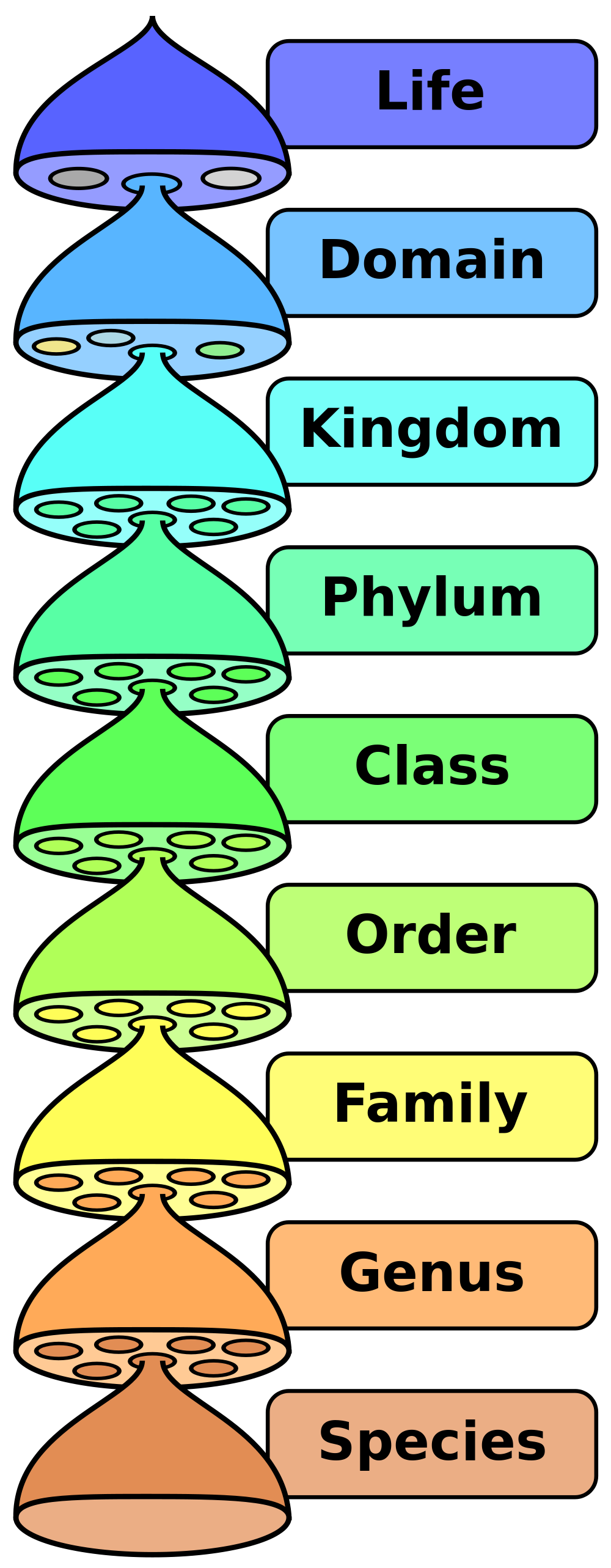
hared obvious morphological traits, such as number of legs or shape of leaves. For his contribution, Linnaeus is known as the “father of taxonomy.”
The Linnaean system of classification consists of a hierarchy of groupings, called taxa (singular, taxon). In the original system, taxa ranged from the kingdom to the species. The kingdom (ex. plant kingdom, animal kingdom) is the largest and most inclusive grouping. It consists of organisms that share just a few basic similarities. The species is the smallest and most exclusive grouping. Ideally, it consists of organisms that are similar enough to interbreed, as discussed above. Similar species are classified together in the same genus (plural, genera), then similar genera are classified together in the same family, and so on, all the way up to the kingdom.
A phrase to help you remember the order of the groupings is shown below. The first letter of each word is the first letter of the level of classification.
Dad Keeps Pots Clean Or Family Gets Sick
The hierarchy of taxa in the original Linnaean system of taxonomy included taxa from the species to the kingdom. The domain was added later.
Binomial Nomenclature
Perhaps the single greatest contribution Linnaeus made to science was his method of naming species. This method, called binomial nomenclature, gives each species a unique, two-word Latin name consisting of the genus name followed by a specific species identifier. An example is Homo sapiens, the two-word Latin name for humans. It literally means “wise human.” This is a reference to our big brains.
Why is having two names so important? It is similar to people having a first and a last name. You may know several people with the first name Michael, but adding Michael’s last name usually pins down exactly which Michael you mean. In the same way, having two names for a species helps to uniquely identify it.
Revisions in the Linnaean Classification
Linnaeus published his classification system in the 1700s. Since then, many new species have been discovered. Scientists can also now classify organisms on the basis of their biochemical and genetic similarities and differences, and not just their outward morphology. These changes have led to revisions in the original Linnaean system of classification.
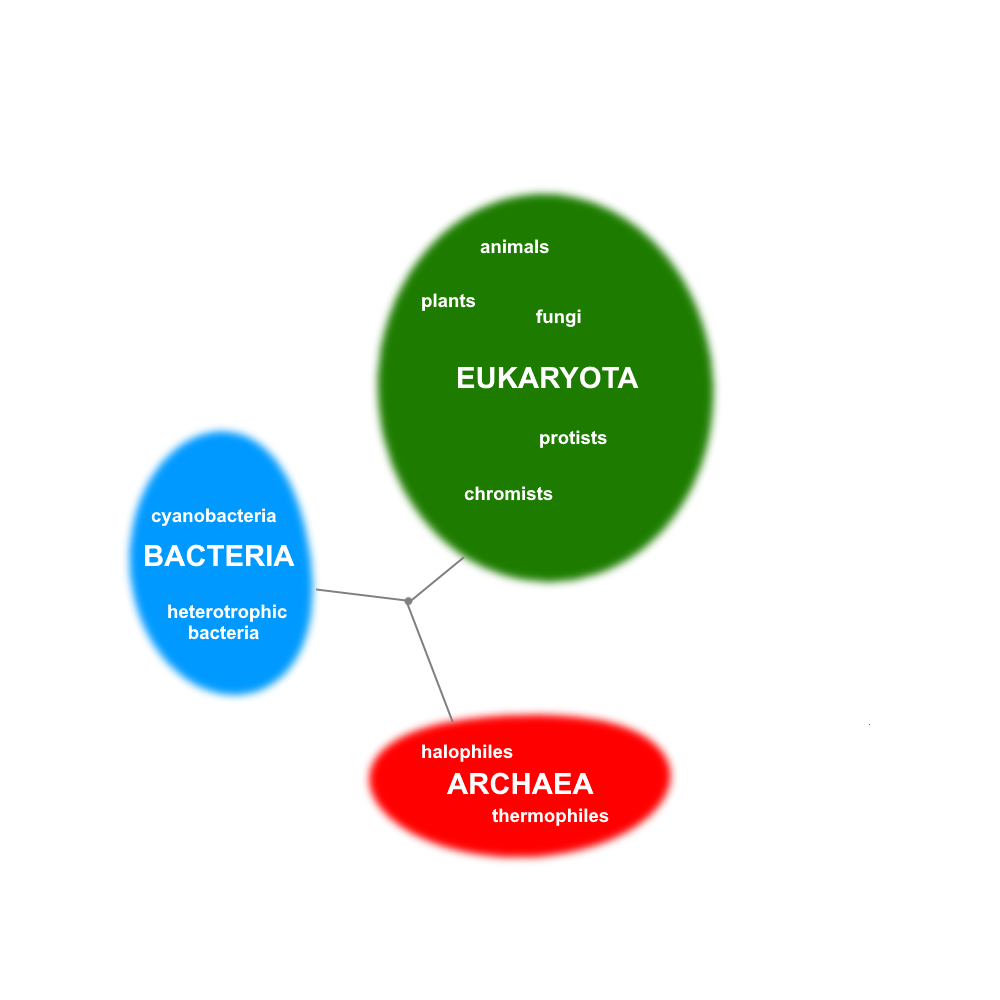
A major change to the Linnaean system is the addition of a new taxon called the domain. The domain is a taxon that is larger and more inclusive than the kingdom, as shown in the figure above. Most biologists agree that there are three domains of life on Earth: Bacteria, Archaea, and Eukarya . Both the Bacteria and the Archaea domains consist of single-celled organisms that lack a nucleus. This means that their genetic material is not enclosed within a membrane inside the cell. The Eukarya domain, in contrast, consists of all organisms whose cells do have a nucleus, so that their genetic material is enclosed within a membrane inside the cell. The Eukarya domain is made up of both single-celled and multicellular organisms. This domain includes several kingdoms, including the animal, plant, fungus, and protist kingdoms.
The three domains of life, as well as how they are related to each other and to a common ancestor. There are several theories about how the three domains are related and which arose first, or from another.
Phylogenetic Classification
Linnaeus classified organisms based on morphology. Basically, organisms were grouped together if they looked alike. After Darwin published his theory of evolution in the 1800s, scientists looked for a way to classify organisms that accounted for phylogeny. Phylogeny is the evolutionary history of a group of related organisms. It is represented by a phylogenetic tree, or some other tree-like diagram, like the one shown above to illustrate the three domains. A phylogenetic tree shows how closely related different groups of organisms are to one another. Each branching point represents a common ancestor of the branching groups.
2.4 Summary
- Biodiversity refers to the variety of life that exists on Earth. It includes species diversity, genetic diversity (within species), and ecosystem diversity.
- The formal biological definition of species is a group of actually or potentially interbreeding organisms. Our own species, Homo sapiens,is an example. In reality, organisms are often classified into species on the basis of morphology.
- A system for classifying living things was introduced by Linnaeus in the 1700s. It includes taxa from the species (least inclusive) to the kingdom (most inclusive). Linnaeus also introduced a system of naming species, which is called binomial nomenclature.
- The domain — a taxon higher than the kingdom — was later added to the Linnaean system. Living things are generally grouped into three domains: Bacteria, Archaea, and Eukarya. The human species and other animal species are placed in the Eukarya domain.
- Modern systems of classification take into account phylogenies, or evolutionary histories of related organisms, rather than just morphological similarities and differences. These relationships are often represented by phylogenetic trees or other tree-like diagrams
2.4 Review Questions
- What is biodiversity? Identify three ways that biodiversity may be measured.
- Define biological species. Why is this definition often difficult to apply?
- Explain why it is important to classify living things, and outline the Linnaean system of classification.
- What is binomial nomenclature? Give an example.
-
- Contrast the Linnaean and phylogenetic systems of classification.
- Describe the taxon called the domain, and compare the three widely recognized domains of living things.
- Based on the phylogenetic tree for the three domains of life above, explain whether you think Bacteria are more closely related to Archaea or Eukarya.
- A scientist discovers a new single-celled organism. Answer the following questions about this discovery.
- If this is all you know, can you place the organism into a particular domain? If so, what is the domain? If not, why not?
- What is one type of information that could help the scientist classify the organism?
- Define morphology. Give an example of a morphological trait in humans.
- Which type of biodiversity is represented in the differences between humans?
- Why do you think it is important to the definition of a species that members of a species can produce fertile offspring?
- Go to the A-Z Animals Animal Classification Page. In the search box, put in your favorite animal and write out it's classification.
2.4 Explore More
https://youtu.be/DVouQRAKxYo
Classification, Amoeba Sisters, 2013.
Attributions
Figure 2.4.1 (6 Kingdoms collage)
- Salmonella, by unknown/ NIAID on Wikimedia Commons is in the public domain (https://en.wikipedia.org/wiki/Public_domain).
- Fern from pxhere, is used under a CC0 1.0 universal public domain dedication license (https://creativecommons.org/publicdomain/zero/1.0/deed.en).
- Photo [squirrel] , by Radoslaw Prekurat on Unsplash is used under the Unsplash License (https://unsplash.com/license).
- Blood Milk Mushroom by Hans on Pixabay is used under the Pixabay License (https://pixabay.com/de/service/license/).
- Fungi by Ste Wright on Unsplash is used under the Unsplash License (https://unsplash.com/license).
- EscherichiaColi NIAID [adapted], by Rocky Mountain Laboratories, ca:NIAID, ca:NIH on Wikimedia Commons is in the public domain (https://en.wikipedia.org/wiki/Public_domain).
Figure 2.4.2
Biological classification, by Pengo [Peter Halasz] on Wikimedia Commons is in the public domain (https://en.wikipedia.org/wiki/Public_domain).
Figure 2.4.3
The three domains of life and major groups within, by C. Miller, 2019, is in the public domain (https://en.wikipedia.org/wiki/Public_domain).
References
Amoeba Sisters. (2017, March 8). Classification. YouTube. https://www.youtube.com/watch?v=DVouQRAKxYo&feature=youtu.be
A-Z Animals. (2008, December 1). Animal classification. https://a-z-animals.com/reference/animal-classification/
TED-Ed. (2015, April 20). Why is biodiversity so important? - Kim Preshoff. YouTube. https://www.youtube.com/watch?v=GK_vRtHJZu4
Wikipedia contributors. (2020, June 21). Carl Linnaeus. Wikipedia. https://en.wikipedia.org/w/index.php?title=Carl_Linnaeus&oldid=963767022
Image shows a squirrel monkey perching in the branches of a tree.
Created by CK-12 Foundation/Adapted by Christine Miller

Oxygen Bar
Belly up to the bar and get your favorite... oxygen? That’s right — in some cities, you can get a shot of pure oxygen, with or without your choice of added flavors. Bar patrons inhale oxygen through a plastic tube inserted into their nostrils, paying up to a dollar per minute to inhale the pure gas. Proponents of the practice claim that breathing in extra oxygen will remove toxins from the body, strengthen the immune system, enhance concentration and alertness, increase energy, and even cure cancer! These claims, however, have not been substantiated by controlled scientific studies. Normally, blood leaving the lungs is almost completely saturated with oxygen, even without the use of extra oxygen, so it’s unlikely that a higher concentration of oxygen in air inside the lungs would lead to significantly greater oxygenation of the blood. Oxygen enters the blood in the lungs as part of the process of gas exchange.
What is Gas Exchange?
Gas exchange is the biological process through which gases are transferred across cell membranes to either enter or leave the blood. Oxygen is constantly needed by cells for aerobic cellular respiration, and the same process continually produces carbon dioxide as a waste product. Gas exchange takes place between the blood and cells throughout the body, with oxygen leaving the blood and entering the cells, and carbon dioxide leaving the cells and entering the blood. Gas exchange also takes place between the blood and the air in the lungs, with oxygen entering the blood from the inhaled air inside the lungs, and carbon dioxide leaving the blood and entering the air to be exhaled from the lungs.
Gas Exchange in the Lungs
Alveoli are the basic functional units of the lungs where gas exchange takes place between the air and the blood. Alveoli (singular, alveolus) are tiny air sacs that consist of connective and epithelial tissues. The connective tissue includes elastic fibres that allow alveoli to stretch and expand as they fill with air during inhalation. During exhalation, the fibres allow the alveoli to spring back and expel the air. Special cells in the walls of the alveoli secrete a film of fatty substances called surfactant. This substance prevents the alveolar walls from collapsing and sticking together when air is expelled. Other cells in alveoli include macrophages, which are mobile scavengers that engulf and destroy foreign particles that manage to reach the lungs in inhaled air.
As shown in Figure 13.4.2, alveoli are arranged in groups like clusters of grapes. Each alveolus is covered with epithelium that is just one cell thick. It is surrounded by a bed of pulmonary capillaries, each of which has a wall of epithelium just one cell thick. As a result, gases must cross through only two cells to pass between an alveolus and its surrounding capillaries.

The pulmonary artery (also shown in Figure 13.4.2) carries deoxygenated blood from the heart to the lungs. Then, the blood travels through the pulmonary capillary beds, where it picks up oxygen and releases carbon dioxide. The oxygenated blood then leaves the lungs and travels back to the heart through pulmonary veins. There are four pulmonary veins (two for each lung), and all four carry oxygenated blood to the heart. From the heart, the oxygenated blood is then pumped to cells throughout the body.
Mechanism of Gas Exchange
Gas exchange occurs by diffusion across cell membranes. Gas molecules naturally move down a concentration gradient from an area of higher concentration to an area of lower concentration. This is a passive process that requires no energy. To diffuse across cell membranes, gases must first be dissolved in a liquid. Oxygen and carbon dioxide are transported around the body dissolved in blood. Both gases bind to the protein hemoglobin in red blood cells, although oxygen does so more effectively than carbon dioxide. Some carbon dioxide also dissolves in blood plasma.
As shown in Figure 13.4.3, oxygen in inhaled air diffuses into a pulmonary capillary from the alveolus. Carbon dioxide in the blood diffuses in the opposite direction. The carbon dioxide can then be exhaled from the body.
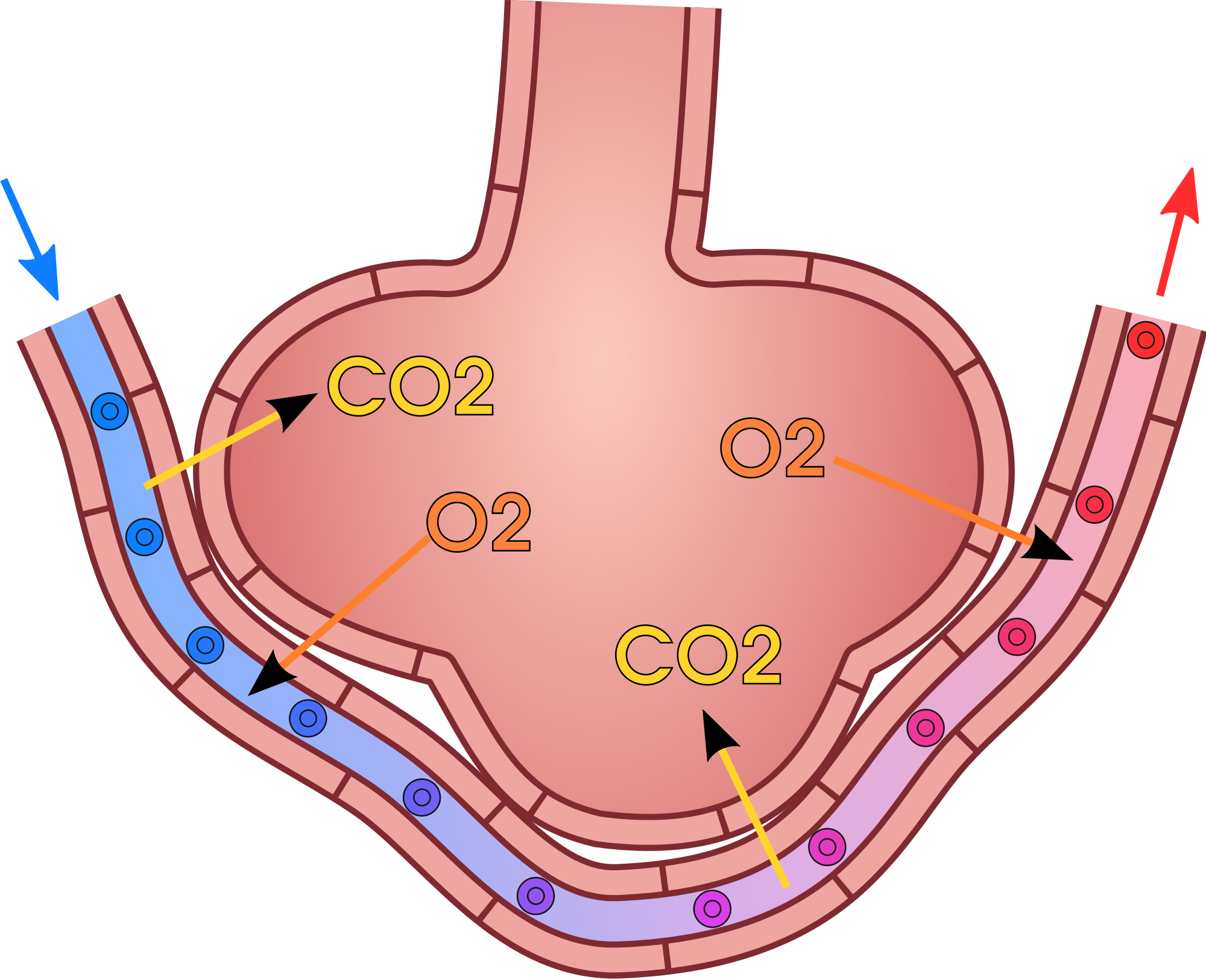
Gas exchange by diffusion depends on having a large surface area through which gases can pass. Although each alveolus is tiny, there are hundreds of millions of them in the lungs of a healthy adult, so the total surface area for gas exchange is huge. It is estimated that this surface area may be as great as 100 m2 (or approximately 1,076 ft²). Often we think of lungs as balloons, but this type of structure would have very limited surface area and there wouldn't be enough space for blood to interface with the air in the alveoli. The structure alveoli take in the lungs is more like a giant mass of soap bubbles — millions of tiny little chambers making up one large mass — this is what increases surface area giving blood lots of space to come into close enough contact to exchange gases by diffusion.
Gas exchange by diffusion also depends on maintaining a steep concentration gradient for oxygen and carbon dioxide. Continuous blood flow in the capillaries and constant breathing maintain this gradient.
- Each time you inhale, there is a greater concentration of oxygen in the air in the alveoli than there is in the blood in the pulmonary capillaries. As a result, oxygen diffuses from the air inside the alveoli into the blood in the capillaries. Carbon dioxide, in contrast, is more concentrated in the blood in the pulmonary capillaries than it is in the air inside the alveoli. As a result, carbon dioxide diffuses in the opposite direction.
- The cells of the body have a much lower concentration of oxygen than does the oxygenated blood that reaches them in peripheral capillaries, which are the capillaries that supply tissues throughout the body. As a result, oxygen diffuses from the peripheral capillaries into body cells. The opposite is true of carbon dioxide. It has a much higher concentration in body cells than it does in the blood of the peripheral capillaries. Thus, carbon dioxide diffuses from body cells into the peripheral capillaries.
13.4 Summary
- Gas exchange is the biological process through which gases are transferred across cell membranes to either enter or leave the blood. Gas exchange takes place continuously between the blood and cells throughout the body, and also between the blood and the air inside the lungs.
- Gas exchange in the lungs takes place in alveoli, which are tiny air sacs surrounded by networks of capillaries. The pulmonary artery carries deoxygenated blood from the heart to the lungs, where it travels through pulmonary capillaries, picking up oxygen and releasing carbon dioxide. The oxygenated blood then leaves the lungs through pulmonary veins.
- Gas exchange occurs by diffusion across cell membranes. Gas molecules naturally move down a concentration gradient from an area of higher concentration to an area of lower concentration. This is a passive process that requires no energy.
- Gas exchange by diffusion depends on the large surface area provided by the hundreds of millions of alveoli in the lungs. It also depends on a steep concentration gradient for oxygen and carbon dioxide. This gradient is maintained by continuous blood flow and constant breathing.
13.4 Review Questions
- What is gas exchange?
- Summarize the flow of blood into and out of the lungs for gas exchange.
-
- Describe the mechanism by which gas exchange takes place.
- Identify the two main factors upon which gas exchange by diffusion depends.
- If the concentration of oxygen were higher inside of a cell than outside of it, which way would the oxygen flow? Explain your answer.
- Why is it important that the walls of the alveoli are only one cell thick?
13.4 Explore More
https://www.youtube.com/watch?v=nRpwdwm06Ic&feature=emb_logo
Oxygen movement from alveoli to capillaries | NCLEX-RN | Khan Academy, khanacademymedicine, 2013.
https://www.youtube.com/watch?v=KmgIqVwytwA&feature=emb_logo
About Carbon Monoxide and Carbon Monoxide Poisoning, EMDPrepare, 2009.
https://www.youtube.com/watch?v=GVU_zANtroE
Oxygen’s surprisingly complex journey through your body - Enda Butler, TED-Ed, 2017.
Attributions
Figure 13.4.1
Oxygen Bar by Farrukh on Flickr is used under a CC BY-NC 2.0 (https://creativecommons.org/licenses/by-nc/2.0/) license.
Figure 13.4.2
Alveolus_diagram.svg by Mariana Ruiz Villarreal [LadyofHats] on Wikimedia Commons is released into the public domain (https://en.wikipedia.org/wiki/Public_domain).
Figure 13.4.3
Gas_exchange_in_the_aveolus.svg by domdomegg on Wikimedia Commons is used under a CC BY 4.0 (https://creativecommons.org/licenses/by/4.0) license.
References
EMDPrepare. (2009, December 21). About carbon monoxide and carbon monoxide poisoning. YouTube. https://www.youtube.com/watch?v=KmgIqVwytwA&feature=youtu.be
khanacademymedicine. (2013, February 25). Oxygen movement from alveoli to capillaries | NCLEX-RN | Khan Academy. YouTube. https://www.youtube.com/watch?v=nRpwdwm06Ic&feature=youtu.be
TED-Ed. (2017, April 13). Oxygen’s surprisingly complex journey through your body - Enda Butler. YouTube. https://www.youtube.com/watch?v=GVU_zANtroE&feature=youtu.be
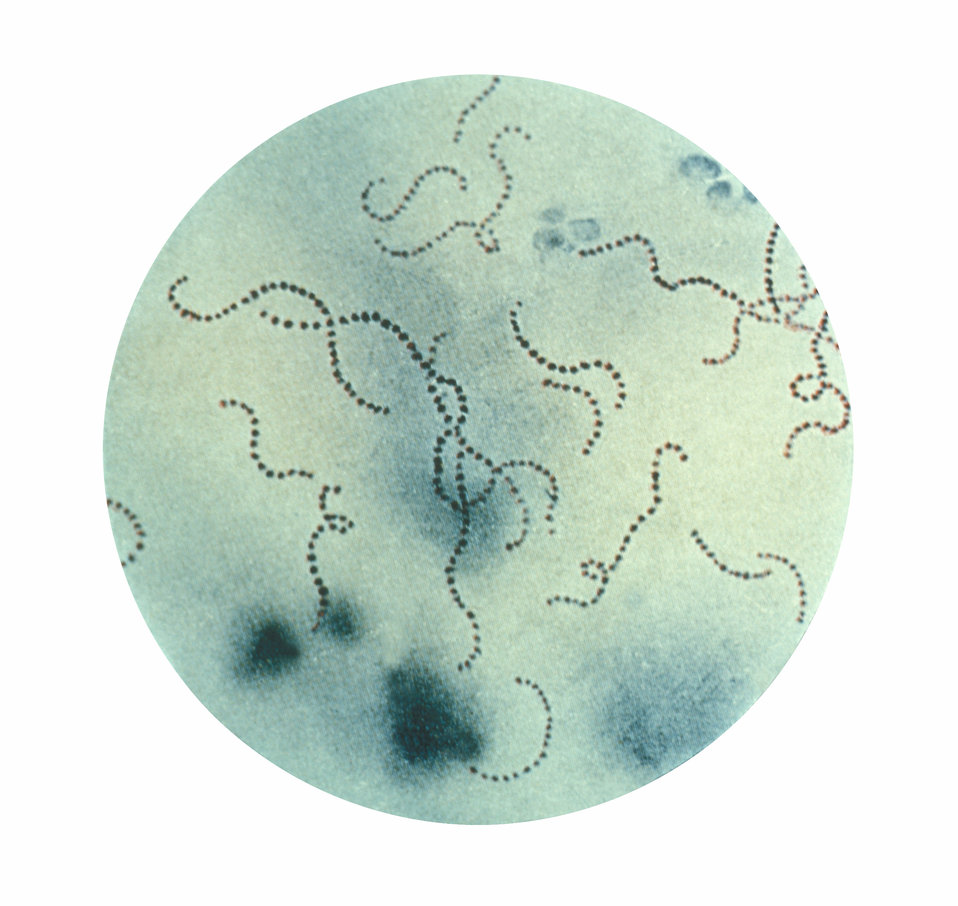
As you may recall from the beginning of the chapter, Lanying’s strep throat was caused by Streptococcus pyogenes bacteria, the species shown in the photomicrograph in Figure 2.6.1. She took antibiotics to treat the S. pyogenes infection, but this also affected her “good” bacteria, throwing off the balance of microorganisms living inside her and resulting in diarrhea and a yeast infection.
After reading this chapter, you should know that microorganisms such as bacteria and yeast that live in humans are also similar to us in many ways. They are living organisms, so we share the traits of homeostasis, organization, metabolism, growth, adaptation, response to stimuli, and reproduction. Like us, microorganisms contain genes, consist of cells, and have the ability to evolve. Lanying’s beneficial gut bacteria help digest her food as part of their metabolic processes. Lanying got a yeast infection likely because the growth and reproductive rates of the yeast living on her body were not held in check by beneficial bacteria after she took the antibiotics. You can see there are many ways in which an understanding of the basic characteristics of all life can directly apply to your own.
You also learned how living organisms are classified, from bacteria that are in the Bacteria domain, to yeast (fungus kingdom) and humans (animal kingdom) which are both in the Eukarya domain. You probably now recognize that Streptococcus pyogenes is the binomial nomenclature for this species, and the fact that Streptococcus refers to the genus name.
As Lanying’s doctor told her, there are many different species of microorganisms living in the human digestive system. You should recognize this type of biodiversity is called species diversity. This diversity is maintained in a balance, or homeostasis, that can be upset when one type of organism is killed, for instance, by antibiotics.
Lanying’s doctor advised her to complete the entire course of antibiotics because stopping too early would kill or inhibit the bacteria that are most susceptible to the antibiotic, while leaving the bacteria that are more resistant to the antibiotic alive. This difference in susceptibility to antibiotics is an example of genetic diversity. Over time, the surviving antibiotic-resistant bacteria will have increased survival and reproductive rates compared to the more susceptible bacteria, and the trait of antibiotic resistance will become more common in the population. In this way, bacteria can evolve and become better adapted to its environment — at a major cost to our health, because our antibiotics will no longer be effective! Improper use of antibiotics leading to increased antibiotic resistance is an issue of major concern to public health experts.

Lanying's doctor suggested that she also take some probiotics — food or supplements that contain "good microorganisms." These good bacteria help our bodies digest food and keep out "bad microorganisms." Specifically, lactobacillus acidophilus could help combat her yeast infection and help restore normal gut function.
After reading this chapter, you know how humans are classified, and you've learned some characteristics of humans and other closely related species. Beyond our more obvious features of big brains, intelligence, and the ability to walk upright, we also serve as a home to many different microorganisms that may be invisible to the naked eye but play a big role in maintaining our health.
Chapter 2 Summary
In this chapter, you learned about the basic principles of biology and how humans are situated among other living organisms. Specifically, you learned:
- To be classified as a living thing, most scientists agree that an object must exhibit seven characteristics, including:
- Maintaining a more-or-less constant internal environment, which is called homeostasis.
- Having multiple levels of organization and consisting of one or more cells.
- Using energy and being capable of metabolism.
- Being able to grow and develop.
- Being capable of evolving adaptations to the environment.
- Being able to detect and respond to environmental stimuli.
- Being capable of reproducing, which is the process by which living things give rise to offspring.
- Four basic principles or theories unify all the fields of biology: cell theory, gene theory, homeostasis, and evolutionary theory.
- According to cell theory, all living things are made of cells and come from other living cells.
- Gene theory states that the characteristics of living things are controlled by genes that pass from parents to offspring.
- All living things — and even the entire biosphere — strive to maintain homeostasis.
- The characteristics of living things change over time as they evolve, and some acquire adaptations or traits that better suit them to a given environment.
- Biodiversity refers to the variety of life that exists on Earth. It includes species diversity, genetic diversity within species, and ecosystem diversity.
- The formal biological definition of "species" is a group of actually or potentially interbreeding organisms. In reality, organisms are often classified into species on the basis of morphology.
- A system for classifying living things was introduced by Linnaeus in the 1700s. It includes taxa from the species (least inclusive) to the kingdom (most inclusive). Linnaeus also introduced a system of naming species, called binomial nomenclature.
- The domain, a taxon higher than the kingdom, was later added to the Linnaean system. Living things are generally grouped into three domains: Bacteria, Archaea, and Eukarya. Humans and other animal species are placed in the Eukarya domain.
- Modern systems of classification take into account phylogenies, or evolutionary histories of related organisms, rather than just morphological similarities and differences. These relationships are often represented by phylogenetic trees or other tree-like diagrams.
- The human species, Homo sapiens, is placed in the primate order of the class of mammals, which are chordates in the animal kingdom.
- Traits that humans share with other primates include: five digits with nails and opposable thumbs; an excellent sense of vision, including stereoscopic vision and the ability to see in colour; and a large brain, high degree of intelligence, and complex behaviors. Like most other primates, we also live in social groups. Many of our primate traits are adaptations to life in the trees.
- Within the primate order, our species is placed in the hominid family, which also includes chimpanzees, gorillas, and orangutans.
- The genus Homo first evolved about 2.8 million years ago. Early Homo species were fully bipedal but had small brains. All are now extinct.
- During the last 800 thousand years, Homo sapiens evolved, with smaller faces, jaws, and front teeth, but much bigger brains than earlier Homo species.
Now you understand the basic principles of biology and some of the characteristics of living organisms. In the next chapter, you will learn about the molecules that make up living organisms, as well as the chemistry that allows organisms to exist and function.
Chapter 2 Review
- What are the four basic unifying principles of biology?
- A scientist is exploring in a remote area with many unidentified species. He finds an unknown object that does not appear to be living. What is one way he could tell whether it is a dead organism that was once alive or an inanimate object that was never living?
- Cows are dependent on bacteria living in their digestive systems to help break down cellulose in the plant material that they eat. Explain what characteristics these bacteria must have to be considered living organisms themselves (and not just part of the cow).
- What is the basic unit of structure and function in living things?
- Give one example of homeostasis that occurs in humans.
- Can a living thing exist without using energy? Why or why not?
-
-
- Give an example of a response to stimuli that occurs in a unicellular organism.
- A scientist discovers two types of similar looking insects that have not been previously identified. Answer the following questions about this discovery.
- What is one way she can try to determine whether the two types are the same species?
- If they are not the same species, what are some ways she can try to determine how closely related they are to each other?
- What is the name for a type of diagram she can create to demonstrate their evolutionary relationship to each other and to other insects?
- If she determines that the two types are different species but the same genus, create your own names for them using binomial nomenclature. You can be creative and make up the genus and species names, but be sure to put them in the format of binomial nomenclature.
- If they are the same species but have different colours, what kind of biodiversity does this most likely reflect?
- If they are the same species, but one type of insect has a better sense of smell for their limited food source than the other type, what do you think will happen over time? Assume the insects will experience natural selection.
- Amphibians, such as frogs, have a backbone, but no hair. What is the most specific taxon that they share with humans?
- What is one characteristic of extinct Homo species that was larger than that of modern humans?
- What is one characteristic of modern humans that is larger than that of extinct Homo species?
- How does the long period of dependency (of infants on adults) in primates relate to learning?
- Name one type of primate in the hominid family, other than humans.
- Why do you think that scientists compare the bones of structures (such as the feet) of extinct Homo species to ours?
- Some mammals other than primates — such as cats — also have their eyes placed in the front of their face. How do you think the vision of a cat compares to that of a mouse, where the eyes are placed more at the sides?
- Living sponges are animals. Are we in the same kingdom as sponges? Explain your answer.
Attributions
Figure 2.6.1
A photomicrograph of Streptococcus pyogenes bacteria, by Centers for Disease Control and Prevention, Public Health Image Library (PHIL) ID#2109, is in the public domain (https://en.wikipedia.org/wiki/Public_domain).
Figure 2.6.2
Yogurt, by Sara Cervera, 2019, is used under the Unsplash License (https://unsplash.com/license).
References
Wikipedia contributors. (2020, April 3). Lactobacillus acidophilus. Wikipedia. https://en.wikipedia.org/w/index.php?title=Lactobacillus_acidophilus&oldid=948947925
Image shows an operating room. There are several surgeons in gowns, masks and gloves. They are operating on a patient.
The central nervous system organ inside the skull that is the control center of the nervous system.
Created by CK-12/Adapted by Christine Miller
Case Study: Diet Dilemma

Joseph is a college student who has watched his father suffer from complications of type 2 diabetes for the past few years. For people with type 2 diabetes, the hormone insulin does not transmit its signal sufficiently. Insulin normally removes sugar from the bloodstream and brings it into the body’s cells. Diabetes prevents blood sugar levels from being properly regulated, and this can cause damage to the cells.
Diabetes can be treated with insulin injections, as shown above, as well as with dietary modifications, but complications can still occur. Joseph’s father has some nerve damage (or neuropathy) in his feet which makes his feet numb. He didn’t notice when he developed minor injuries to his feet which caused some serious infections.

Joseph is obese and knows that his weight — along with a family history of diabetes — increases his risk of getting the disease himself. He wants to avoid the health issues that his father suffered, so he begins walking every day for exercise and starts to lose weight. Joseph also wants to improve his diet in order to lose more weight, lower his risk of diabetes, and improve his general health, but he is overwhelmed with all of the different dietary advice he reads online and hears from his friends and family.
Joseph’s father tells him to limit refined carbohydrates, such as white bread and rice, because that is what he does to help keep his blood sugar at an acceptable level, but Joseph’s friend tells him that eating a diet high in carbohydrates and low in fat is a good way to lose weight. Joseph reads online that “eating clean” by eating whole, unprocessed foods and avoiding food with “chemicals” can help with weight loss. One piece of advice that everyone seems to agree on is that drinking enough water is good for overall health.
All this dietary advice may sound confusing, but you can better understand health conditions, such as diabetes, and the role of diet and nutrition by understanding chemistry. Chemistry is much more than chemical reactions in test tubes in a lab — it is the atoms, molecules, and reactions that make us who we are and keep us alive and functioning properly. Our diets are one of the main ways our bodies take in raw materials that are needed for the important chemical reactions that take place inside of us.
Chapter Overview: Chemistry
As you read this chapter, you will learn more about how chemistry relates to our lives, health, and the foods we eat. Specifically, you will learn about:
- The nature of chemical substances, including elements, compounds, and their component atoms and molecules.
- The structures and functions of biochemical compounds, including carbohydrates, lipids, proteins, and nucleic acids (such as DNA and RNA).
- What chemical reactions are, how energy is involved in chemical reactions, how enzymes assist in chemical reactions, and some types of biochemical reactions in living organisms.
- Properties of water and the importance of water for most biochemical processes.
- What pH is, and why maintaining a proper pH in the body is important for biochemical reactions.
As you read the chapter, think about the following questions regarding Joseph’s situation, as well as how diabetes and diet relate to the chemistry of life:
- Why do you think Joseph’s father's diabetes increases Joseph's risk of getting diabetes?
- What is the difference between refined (simple) carbohydrates and complex carbohydrates? Why are refined carbohydrates particularly problematic for people with diabetes?
- Insulin is a peptide hormone. In which class of biochemical compounds would you categorize insulin?
- Why is drinking enough water important for overall health? Can you drink too much water?
- Sometimes “eating clean” is described as avoiding “chemicals” in food. Think about the definition of “chemicals” and how it relates to what we eat.
Attributions
Figure 3.1.1
Diabetes-equipment by Steve Buissinne [stevepb] on Pixabay is used under the Pixabay License (https://pixabay.com/de/service/license/).
Figure 3.1.2
Early Morning Hike, by Luke Pamer on Unsplash, is used under the Unsplash license (https://unsplash.com/license).
References
Mayo Clinic Staff. (n.d.). Peripheral neuropathy [online article]. MayoClinic.org. https://www.mayoclinic.org/diseases-conditions/peripheral-neuropathy/symptoms-causes/syc-20352061
Mayo Clinic Staff. (n.d.). Type 2 diabetes [online article]. MayoClinic.org. https://www.mayoclinic.org/diseases-conditions/type-2-diabetes/symptoms-causes/syc-20351193
Image shows an african-american man sitting on a ledge looking out at the sun setting over the ocean.
image shows a diagram of the location of each type of tooth on the bottom jaw. Per side, there are three molars at the very back, just in front of the molars there are two submolars per side, and then one canine on each side. At the very front and center of the lower jaw are four incisors.
Image shows a labelled diagram of organs of the head and neck belonging to the respiratory and digestive systems. These include the nasal cavity, the palate, the oral cavity, the lips, the jaw, tongue, pharynx, epiglottis, larynx, and esophagus. The pharynx is of particular note since it is the last space through which food and air travel. The epiglottis is critical in ensuring that food only enters the esophagus of the digestive system and not the larynx of the respiratory system.
What Are You Made of?

Your entire body is made of cells and cells are made of molecules.If you look at your hand, what do you see? Of course, you see skin, which consists of cells. But what are skin cells made of? Like all living cells, they are made of matter. In fact, all things are made of matter. Matter is anything that takes up space and has mass. Matter, in turn, is made up of chemical substances. A chemical substance is matter that has a definite composition that is consistent throughout. A chemical substance may be either an element or a compound.
Elements and Atoms
An element is a pure substance. It cannot be broken down into other types of substances. Each element is made up of just one type of atom.
Structure of an Atom
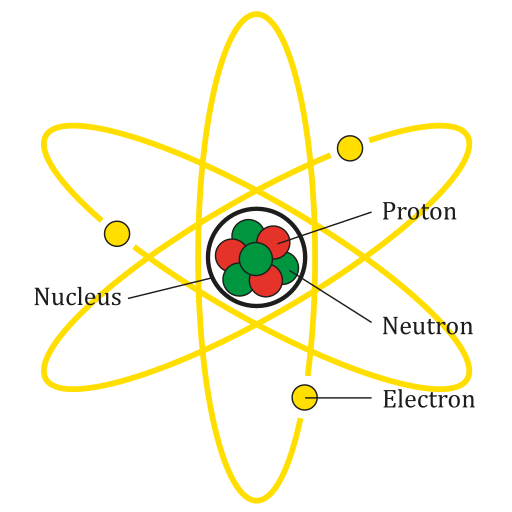
An atom is the smallest particle of an element that still has the properties of that element. Every substance is composed of atoms. Atoms are extremely small, typically about a ten-billionth of a metre in diametre. However, atoms do not have well-defined boundaries, as suggested by the atomic model shown below.
Every atom is composed of a central area — called the nucleus — and one or more subatomic particles called electrons, which move around the nucleus. The nucleus also consists of subatomic particles. It contains one or more protons and typically a similar number of neutrons. The number of protons in the nucleus determines the type of element an atom represents. An atom of hydrogen, for example, contains just one proton. Atoms of the same element may have different numbers of neutrons in the nucleus. Atoms of the same element with the same number of protons — but different numbers of neutrons — are called isotopes.
Protons have a positive electric charge and neutrons have no electric charge. Virtually all of an atom's mass is in the protons and neutrons in the nucleus. Electrons surrounding the nucleus have almost no mass, as well as a negative electric charge. If the number of protons and electrons in an atom are equal, then an atom is electrically neutral, because the positive and negative charges cancel each other out. If an atom has more or fewer electrons than protons, then it has an overall negative or positive charge, respectively, and it is called an ion.
The negatively-charged electrons of an atom are attracted to the positively-charged protons in the nucleus by a force called electromagnetic force, for which opposite charges attract. Electromagnetic force between protons in the nucleus causes these subatomic particles to repel each other, because they have the same charge. However, the protons and neutrons in the nucleus are attracted to each other by a different force, called nuclear force, which is usually stronger than the electromagnetic force. Nuclear force repels the positively-charged protons from each other.
Periodic Table of the Elements
There are almost 120 known elements. As you can see in the Periodic Table of the Elements shown below, the majority of elements are metals. Examples of metals are iron (Fe) and copper (Cu). Metals are shiny and good conductors of electricity and heat. Nonmetal elements are far fewer in number. They include hydrogen (H) and oxygen (O). They lack the properties of metals.
The periodic table of the elements arranges elements in groups based on their properties. The element most important to life is carbon (C). Find carbon in the table. What type of element is it: metal or nonmetal?
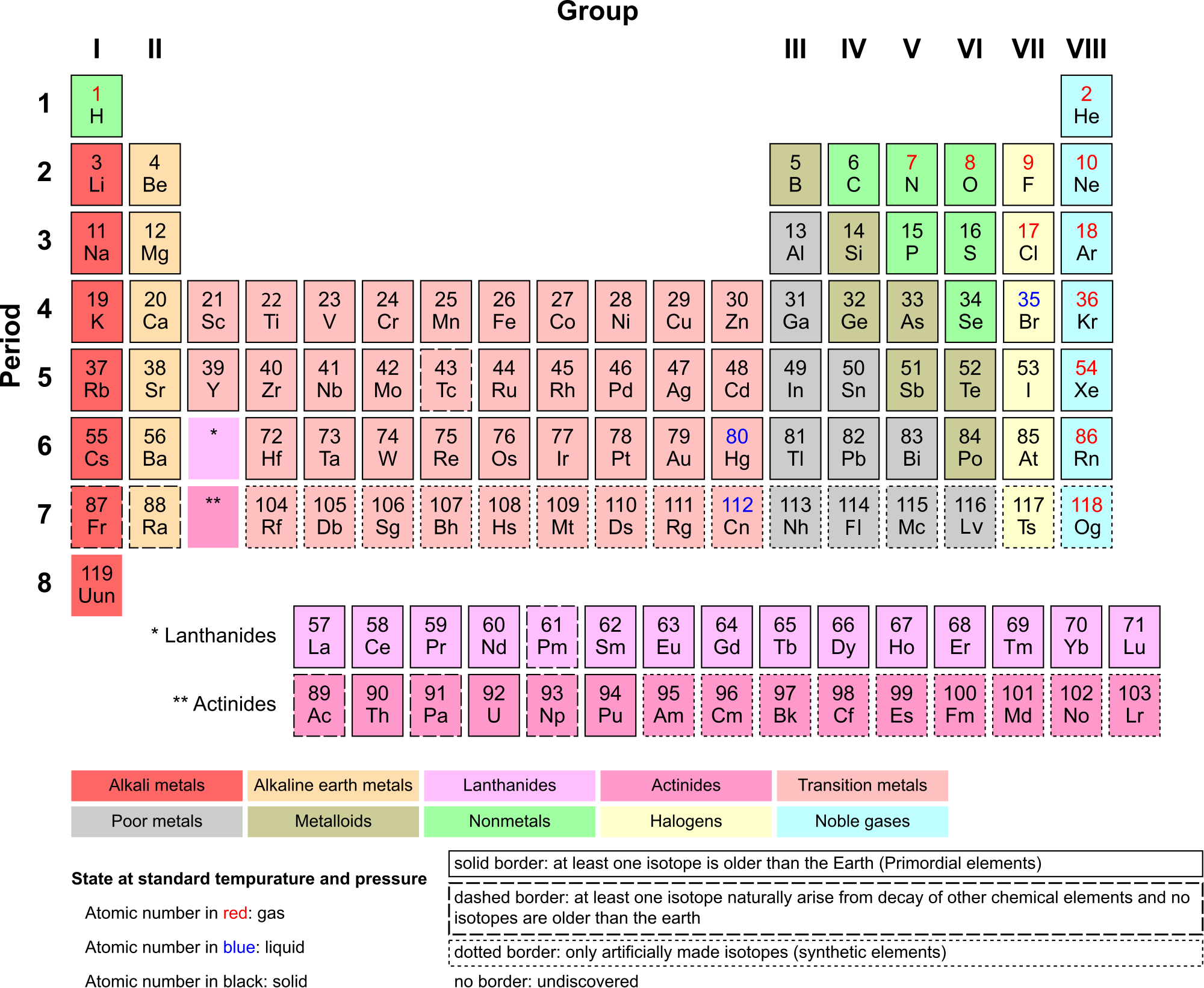
Compounds and Molecules
A compound is a unique substance that consists of two or more elements combined in fixed proportions. This means that the composition of a compound is always the same. The smallest particle of most compounds in living things is called a molecule.

Consider water as an example. A molecule of water always contains one atom of oxygen and two atoms of hydrogen. The composition of water is expressed by the chemical formula H2O. A model of a water molecule is shown in Figure 3.2.4.
What causes the atoms of a water molecule to “stick” together? The answer is chemical bonds. A chemical bond is a force that holds together the atoms of molecules. Bonds in molecules involve the sharing of electrons among atoms. New chemical bonds form when substances react with one another. A chemical reaction is a process that changes some chemical substances into others. A chemical reaction is needed to form a compound, and another chemical reaction is needed to separate the substances in that compound.
3.2 Summary
- All matter consists of chemical substances. A chemical substance has a definite composition which is consistent throughout. A chemical substance may be either an element or a compound.
- An element is a pure substance that cannot be broken down into other types of substances.
- An atom is the smallest particle of an element that still has the properties of that element. Atoms, in turn, are composed of subatomic particles, including negative electrons, positive protons, and neutral neutrons. The number of protons in an atom determines the element it represents.
- Atoms have equal numbers of electrons and protons, so they have no charge. Ions are atoms that have lost or gained electrons, and as a result have either a positive or negative charge. Atoms with the same number of protons — but different numbers of neutrons — are called isotopes.
- There are almost 120 known elements. The majority of elements are metals. A smaller number are nonmetals. The latter include carbon, hydrogen, and oxygen.
- A compound is a substance that consists of two or more elements in a unique composition. The smallest particle of a compound is called a molecule. Chemical bonds hold together the atoms of molecules. Compounds can form only in chemical reactions, and they can break down only in other chemical reactions.
3.2 Review Questions
-
- What is an element? Give three examples.
- Define compound. Explain how compounds form.
- Compare and contrast atoms and molecules.
- The compound called water can be broken down into its constituent elements by applying an electric current to it. What ratio of elements is produced in this process?
- Relate ions and isotopes to elements and atoms.
- What is the most important element to life?
- Iron oxide is often known as rust — the reddish substance you might find on corroded metal. The chemical formula for this type of iron oxide is Fe2O3. Answer the following questions about iron oxide and briefly explain each answer.
- Is iron oxide an element or a compound?
- Would one particle of iron oxide be considered a molecule or an atom?
- Describe the relative proportion of atoms in iron oxide.
- What causes the Fe and O to stick together in iron oxide?
- Is iron oxide made of metal atoms, metalloid atoms, nonmetal atoms, or a combination of any of these?
- 14C is an isotope of carbon used in the radiocarbon dating of organic material. The most common isotope of carbon is 12C. Do you think 14C and 12C have different numbers of neutrons or protons? Explain your answer.
- Explain why ions have a positive or negative charge.
- Name the three subatomic particles described in this section.
3.2 Explore More
https://www.youtube.com/watch?v=yQP4UJhNn0I&feature=emb_logo
Just how small is an atom? TED-Ed, 2012
Attributions
Figure 3.2.1
Man Sitting, by Gregory Culmer, on Unsplash, is used under the Unsplash license (https://unsplash.com/license).
Figure 3.2.2
Lithium Atom diagram, by AG Caesar, is used under a CC BY-SA 4.0 (https://creativecommons.org/licenses/by-sa/4.0/deed.en)
Figure 3.2.3
Periodic Table Armtuk3, by Armtuk, is used under a CC BY-SA 3.0 (https://creativecommons.org/licenses/by-sa/3.0/) license.
Figure 3.2.4
Water molecule, by Sakurambo, is released into the public domain (https://en.wikipedia.org/wiki/Public_domain).
References
TED-Ed. (2012, April 16). Just how small is an atom. YouTube. https://www.youtube.com/watch?v=yQP4UJhNn0I&feature=youtu.be
The semipermeable membrane surrounding the cytoplasm of a cell.
Image shows the pathway of events in the activation of T Cells. This includes: 1) T Cells are activated when they encounter a foreign antigen on an MHC from an antigen-presenting cell. 2) Cytokines help the T cell to mature. Some T Cells become helper T cells and continue to produce cytokines. 3) Some T Cells become Killer T Cells and search out and destroy infected or cancerous cells.
Image shows a bowl of kidney beans.
Created by: CK-12/Adapted by Christine Miller
The Cellulose of Our Lives
Created by: CK-12/Adapted by Christine Miller

Where would we be without our jeans? They have been the go-to pants for many people for decades, and they are still as popular as ever. Jeans are made of denim, a type of cotton fabric. Cotton is a soft, fluffy fibre that grows in a protective case around the seeds of cotton plants. The fibre is almost pure cellulose. Cellulose is the single most abundant biochemical compound found in Earth's living things, and it's one of several types of carbohydrates.
What Are Carbohydrates?
Carbohydrates are the most common class of biochemical compounds. They include sugars and starches. Carbohydrates are used to provide or store energy, among other uses. Like most biochemical compounds, carbohydrates are built of small repeating units, or monomers, which form bonds with each other to make larger molecules, called polymers. In the case of carbohydrates, the small repeating units are known as monosaccharides. Each monosaccharide consists of six carbon atoms, as shown in the model of the monosaccharide glucose shown in Figure 3.4.2.
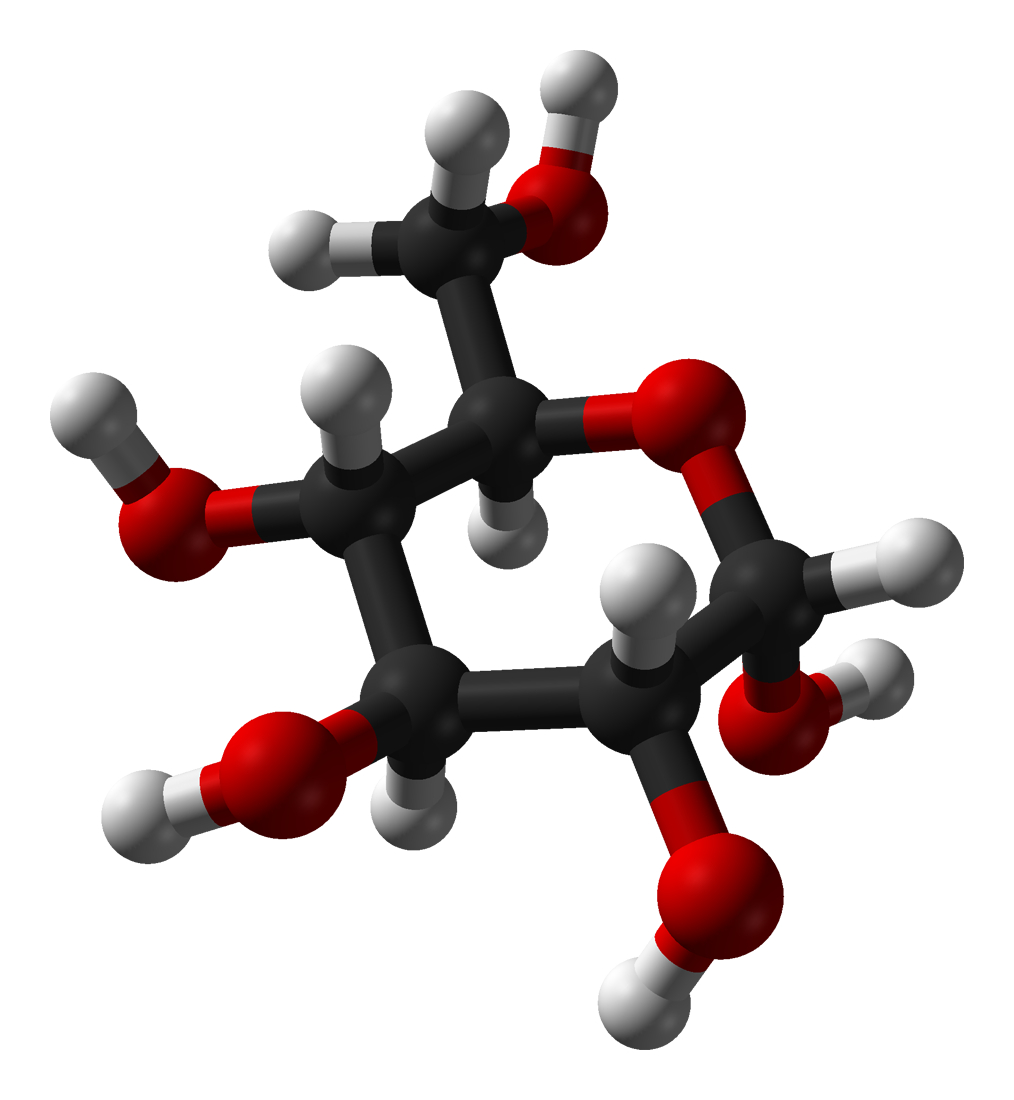
Sugars
Sugars are the general name for sweet, short-chain, soluble carbohydrates, which are found in many foods. Their function in living things is to provide energy. The simplest sugars consist of a single monosaccharide. They include glucose, fructose, and galactose. Glucose is a simple sugar that is used for energy by the cells of living things. Fructose is a simple sugar found in fruits, and galactose is a simple sugar found in milk. Their chemical structures are shown in Figure 3.4.3. All monosaccharides have the formula C6H12O6.
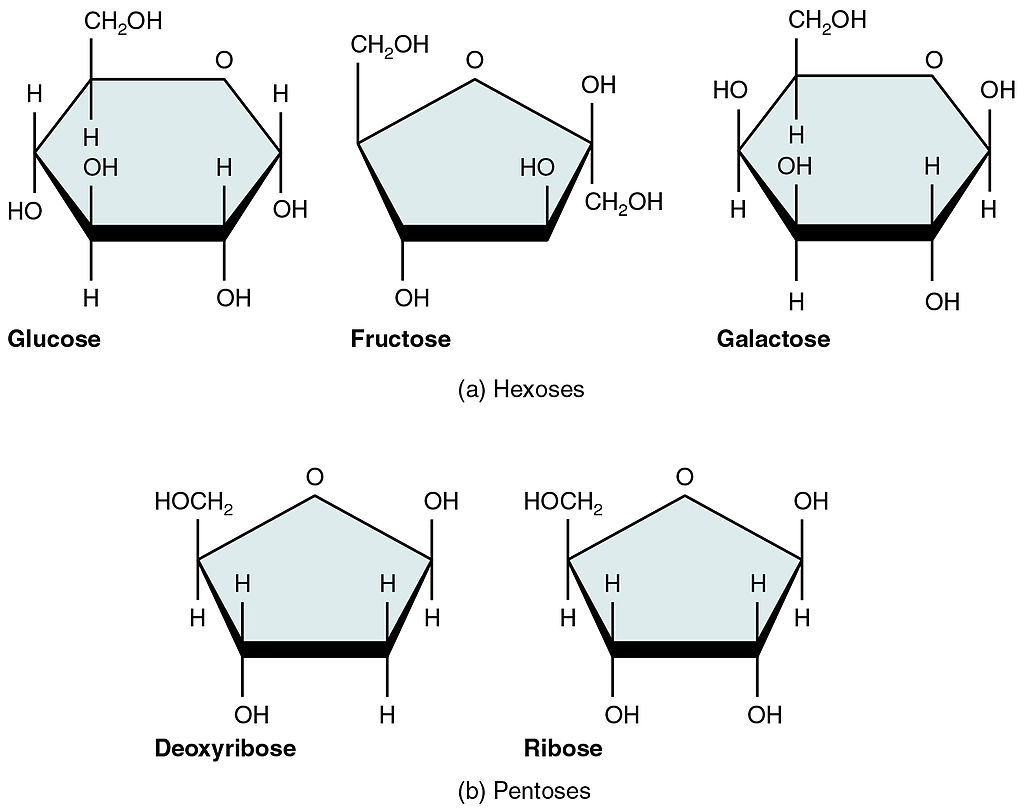
Other sugars contain two monosaccharide molecules and are called disaccharides. These include sucrose (table sugar), maltose, and lactose. Sucrose is composed of one fructose molecule and one glucose molecule, maltose is composed of two glucose molecules, and lactose is composed of one glucose molecule and one galactose molecule. Lactose occurs naturally in milk. Some people are lactose intolerant because they can't digest lactose. If they drink milk, it causes gas, cramps, and other unpleasant symptoms, unless the milk has been processed to remove the lactose.
Complex Carbohydrates
Some carbohydrates consist of hundreds — or even thousands! — of monosaccharides bonded together in long chains. These carbohydrates are called polysaccharides ("many saccharides"). Polysaccharides are also referred to as complex carbohydrates. Complex carbohydrates that are found in living things include starch, glycogen, cellulose, and chitin. Each type of complex carbohydrate has different functions in living organisms, but they generally either store energy or make up certain structures in living things.
Starch

Starch is a complex carbohydrate that is made by plants to store energy. For example, the potatoes pictured in Figure 3.4.4 are packed full of starches that consist mainly of repeating units of glucose and other simple sugars. The leaves of potato plants make sugars by photosynthesis, and the sugars are carried to underground tubers where they are stored as starch. When we eat starchy foods such as potatoes, the starches are broken down by our digestive system into sugars, which provide our cells with energy. Starches are easily and quickly digested with the help of digestive enzymes such as amylase, which is found in the saliva. If you chew a starchy saltine cracker for several minutes, you may start to taste the sugars released as the starch is digested.
Glycogen
Animals do not store energy as starch. Instead, animals store extra energy as the complex carbohydrate glycogen. Glycogen is a polysaccharide of glucose. It serves as a form of energy storage in fungi (as well as animals), and it is the main storage form of glucose in the human body. In humans, glycogen is made and stored primarily in the cells of the liver and muscles. When energy is needed from either storage area, the glycogen is broken down to glucose for use by cells. Muscle glycogen is converted to glucose for use by muscle cells, and liver glycogen is converted to glucose for use throughout the rest of the body. Glycogen forms an energy reserve that can be quickly mobilized to meet a sudden need for glucose, but one that is less compact than the energy reserves of lipids, which are the primary form of energy storage in animals.
Glycogen plays a critical part in the homeostasis of glucose levels in the blood. When blood glucose levels rise too high, excess glucose can be stored in the liver by converting it to glycogen. When glucose levels in the blood fall too low, glycogen in the liver can be broken down to glucose and released into the blood.
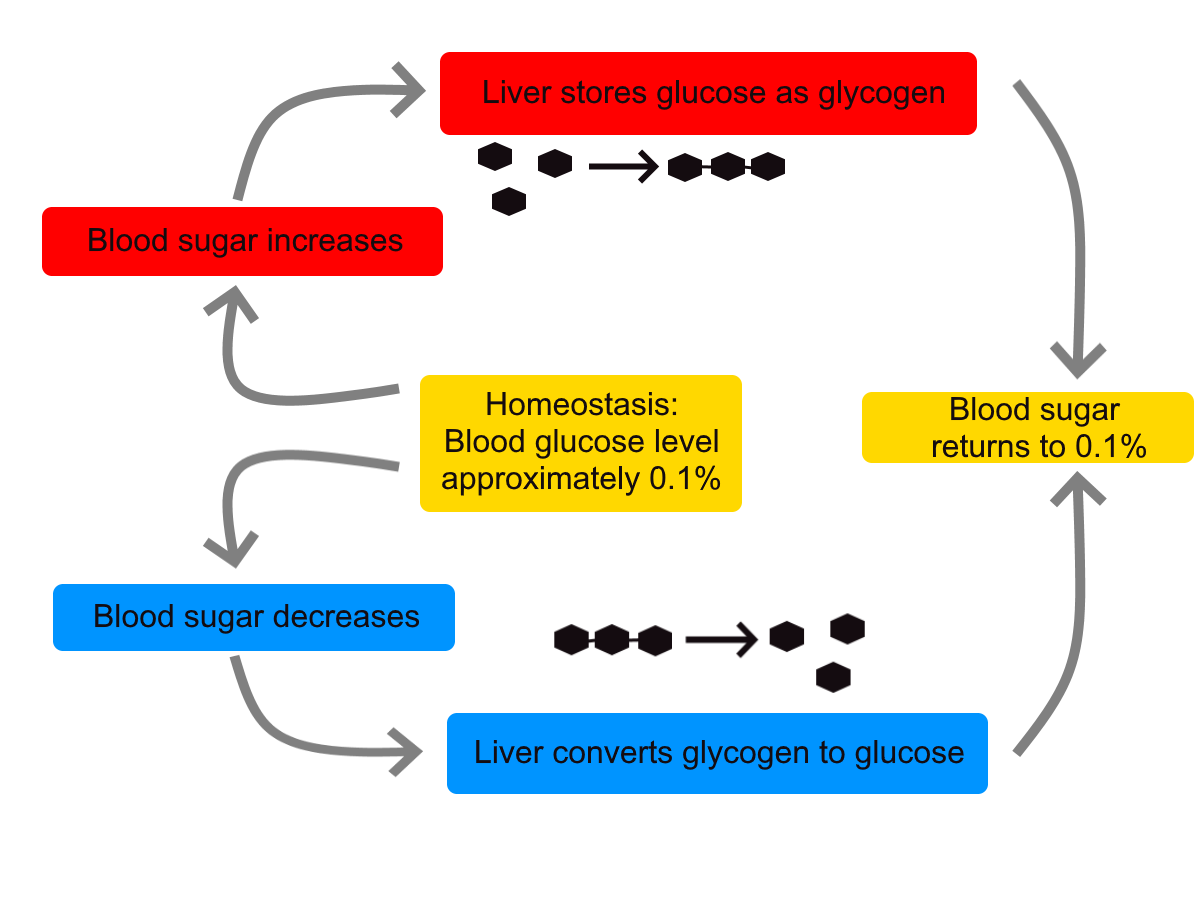
Cellulose

Cellulose is a polysaccharide consisting of a linear chain of several hundred to many thousands of linked glucose units. Cellulose is an important structural component of the cell walls of plants and many algae. Human uses of cellulose include the production of cardboard and paper, which consist mostly of cellulose from wood and cotton. The cotton fibres pictured are about 90 per cent cellulose.
Certain animals, including termites and ruminants such as cows, can digest cellulose with the help of microorganisms that live in their gut. Humans cannot digest cellulose, but it nonetheless plays an important role in our diet. It acts as a water-attracting bulking agent for feces in the digestive tract and is often referred to as "dietary fibre." In simpler terms, it helps you poop.
Chitin
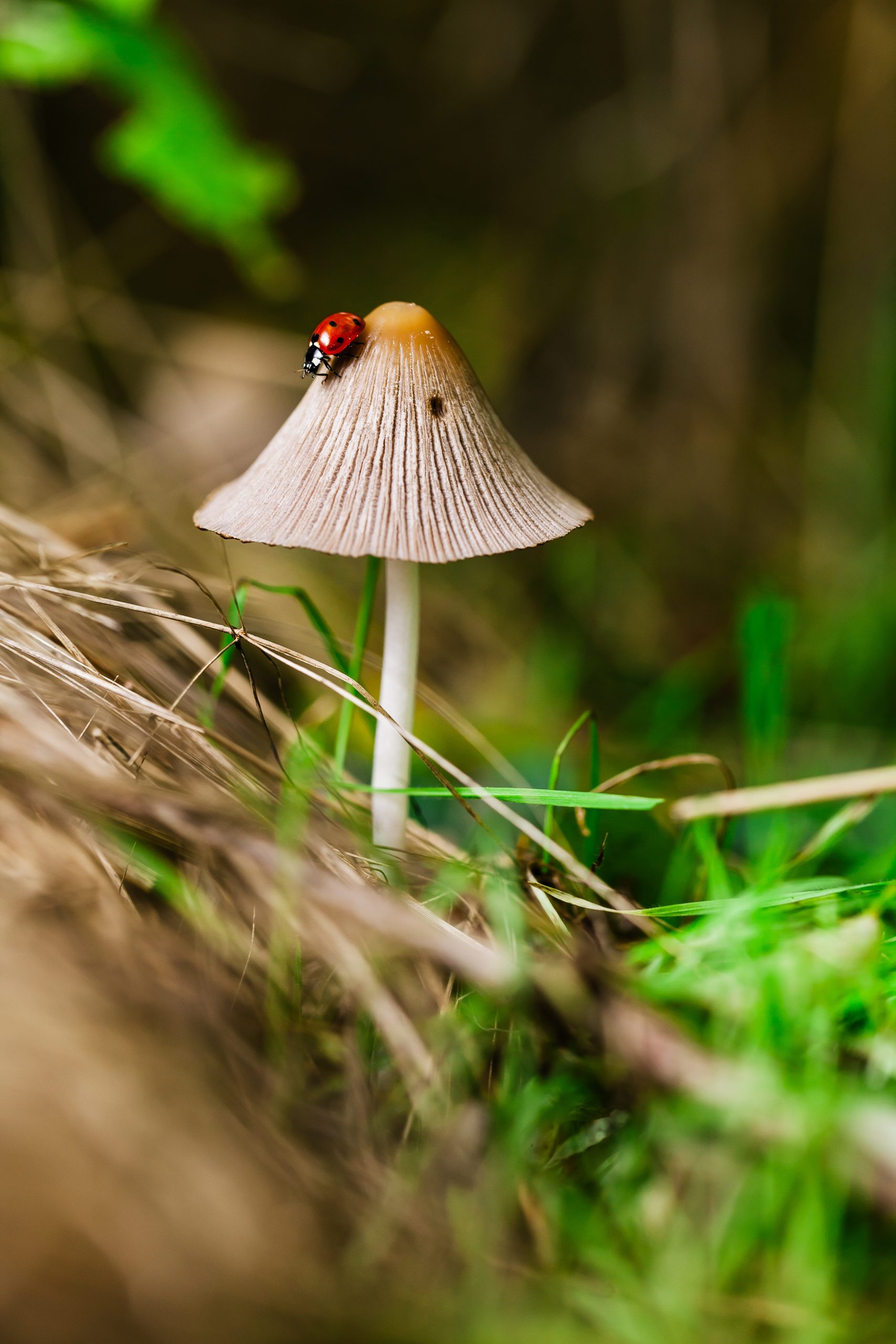
Chitin is a long-chain polymer of a derivative of glucose. It is found in many living things. For example, it is a component of the cell walls of fungi; the exoskeletons of arthropods, such as crustaceans and insects ; and the beaks and internal shells of animals, such as squids and octopuses. The structure of chitin is similar to that of cellulose.
In Figure 3.4.7, both the exoskeleton of the ladybug and the cell walls of the mushroom are made partly of the complex carbohydrate chitin.
The Right Molecule for the Job
Starch, glycogen, cellulose and chitin are all made from the monomer glucose. So how are they all so different? Their difference in structure and function is related to how they are linked together. Starch is linked in long chains with a small amount of branching, glycogen is linked in many branching chains, and chitin and cellulose form long single chains that pack together tightly. Each of these variations of linking the same monomer, glucose, together creates a different way the molecule can be used. As shown in the Figure 3.4.8 diagram, starch and glycogen have many exposed "ends" of their chains. These are areas where a glucose molecule can easily be removed for use as energy, whereas cellulose does not. For this reason, glycogen and starch are well-suited for energy storage in organisms while cellulose is not. Conversely, cellulose packs many monomers together in a sort of mesh that is very strong — this is why it is a great option for building strong cell walls.

Feature: My Human Biology
You probably know that you should eat plenty of fibre, but do you know how much fibre you need, how fibre contributes to good health, or which foods are good sources of fibre? Dietary fibre consists mainly of cellulose, so it is found primarily in plant-based foods, including fruits, vegetables, whole grains, and legumes. Dietary fibre can't be broken down and absorbed by your digestive system. Instead, it passes relatively unchanged through your gastrointestinal tract and is excreted in feces (otherwise known as poop). That's how it helps keep you healthy.

Fibre in food is commonly classified as either soluble or insoluble fibre.
- Soluble fibre dissolves in water to form a gel-like substance as it passes through the gastrointestinal tract. It lowers blood levels of cholesterol and glucose, which is beneficial for your health. Good sources of soluble fibre include whole oats, peas, beans, and apples.
- Insoluble fibre does not dissolve in water. This type of fibre increases the bulk of feces in the large intestine, and helps keep food wastes moving through, which may help prevent or correct constipation. Good sources of insoluble fibre include whole wheat, wheat bran, beans, and potatoes.
How much fibre do you need for good health? That depends on your age and gender. The Institute of Medicine recommends the daily fibre intake for adults shown in Table 3.4.1 below. Most dietitians further recommend a ratio of about three parts of insoluble fibre to one part of soluble fibre each day. Most fibre-rich foods contain both types of fibre, so it usually isn't necessary to keep track of the two types of fibre as long as your overall fibre intake is adequate.
Table 3.4.1
Recommended Daily Fibre Intake for Males and Females
| Recommended Daily Fibre Intake for Males and Females | ||
| Gender | Age 50 or Younger | Age 51 or Older |
| Male | 38 grams | 30 grams |
| Female | 25 grams | 21 grams |
Use food labels like the one shown below in Figure 3.4.10 and online fibre counters to find out how much total fibre you eat in a typical day. Are you consuming enough fibre for good health? If not, consider ways to increase your intake of this important substance. For example, substitute whole grains for refined grains, eat more legumes (such as beans), and try to consume at least five servings of fruits and vegetables each day.

Table 3.4.2
Carbohydrate Comparison
Name |
Class |
Function |
Location |
| Glucose | Monosaccharide | Energy for cells | Cells |
| Starch | Polysaccharide | Energy storage | Plant cells |
| Glycogen | Polysaccharide | Energy storage | Animal cells |
| Cellulose | Polysaccharide | Structural component in cell walls | Plant cells |
| Chitin | Polysaccharide | Structural component in cell walls and exoskeletons | Fungi and arthropods |
3.4 Summary
- Carbohydrates are the most common class of biochemical compounds. The basic building block of carbohydrates is the monosaccharide, which consists of six carbon atoms.
- Sugars are sweet, short-chain, soluble carbohydrates that are found in many foods and supply us with energy. Simple sugars, such as glucose, consist of just one monosaccharide. Some sugars, such as sucrose (or table sugar), consist of two monosaccharides. These are called disaccharides.
- Complex carbohydrates, or polysaccharides, consist of hundreds — or even thousands — of monosaccharides. They include starch, glycogen, cellulose, and chitin. They generally either store energy or form structures, such as cell walls, in living things.
- Starch is a complex carbohydrate that is made by plants to store energy. Potatoes are a good food source of dietary starch, which is readily broken down into its component sugars during digestion.
- Glycogen is a complex carbohydrate that is made by animals and fungi to store energy. Glycogen plays a critical part in the homeostasis of blood glucose levels in humans.
- Cellulose is the single most common biochemical compound in living things. It forms the cell walls of plants and certain algae. Like most other animals, humans cannot digest cellulose, but it makes up most of the crucial dietary fibre in the human diet.
- Chitin is a complex carbohydrate, similar to cellulose, that makes up organic structures, such as the cell walls of fungi and the exoskeletons of insects and other arthropods.
3.4 Review Questions
- What are carbohydrates? Describe their structure.
- Compare and contrast sugars and complex carbohydrates.
-
- If you chew on a starchy food (such as a saltine cracker) for several minutes, it may start to taste sweet. Explain why.
- True or False: Glucose is mainly stored by lipids in the human body.
-
- Name three carbohydrates that contain glucose as a monomer.
- Jeans are made of tough, durable cotton. Based on what you know about the structure of carbohydrates, explain how you think this fabric gets its tough qualities.
- Which do you think is faster to digest — simple sugars or complex carbohydrates? Explain your answer.
- True or False: Cellulose is broken down in the human digestive system into glucose molecules.
- ___________ fibre dissolves in water, __________ fibre does not dissolve in water.
- What are the similarities and differences between muscle glycogen and liver glycogen?
- Which carbohydrate is used directly by the cells of living things for energy?
- Which of the following is not a complex carbohydrate?
- Chitin
- Starch
- Disaccharide
- None of the above
3.4 Explore More
https://youtu.be/wxzc_2c6GMg
How do carbohydrates impact your health? - Richard J. Wood, TED-Ed, 2016
https://www.youtube.com/watch?v=tKLJ6KQAcjI
Why is cotton in everything? - Michael R. Stiff, TED-Ed, 2020
Attributions
Figure 3.4.1
Jeans by Maude Frédérique Lavoie on Unsplash is used under the Unsplash License (https://unsplash.com/license).
Figure 3.4.2
e-from-xtal-1979-Alpha-D-glucose-from-xtal-1979-3D-balls by Ben Mills [Benjah-bmm27] on Wikimedia Commons, is released into the public domain (https://en.wikipedia.org/wiki/Public_domain).
Figure 3.4.3
Monosasccharides by OpenStax College on Wikimedia Commons is used under a CC BY 4.0 (https://creativecommons.org/licenses/by/4.0) license.
Figure 3.4.4
Potatoes by Jean Beaufort, on Public Domain Pictures.net, is used under a CC0 1.0 Universal Public Domain Dedication license (https://creativecommons.org/publicdomain/zero/1.0/).
Figure 3.4.5
Homeostasis_of_blood_sugar by Christine Miller [christinelmiller] Is used under a CC0 1.0 Universal Public Domain Dedication license (https://creativecommons.org/publicdomain/zero/1.0/).
Figure 3.4.6
Cotton by David Nance for Agricultural Research Service, the research agency of the United States Department of Agriculture, on Wikimedia Commons, is released into the public domain (https://en.wikipedia.org/wiki/Public_domain).
Figure 3.4.7
Ladybug on a mushroom /Fungi in the Woods by Benjamin Balázs on Unsplash is used under the Unsplash License (https://unsplash.com/license).
Figure 3.4.8
Carbohydrate structure comparison [Three Important Polysaccharides] by OpenStax College is on Wikimedia Commons, used under a CC BY 3.0 (https://creativecommons.org/licenses/by/3.0) license.
Figure 3.4.9
Beans by Milada Vigerova on Unsplash is used under the Unsplash License (https://unsplash.com/license).
Figure 3.4.10
FDA Nutrition Facts Label 2014, by US Food and Drug Administration, on Wikimedia Commons is released into the public domain (https://en.wikipedia.org/wiki/Public_domain).
Table 3.4.1
Recommended Daily Fibre Intake for Males and Females is from OpenStax, used under a CC BY 4.0 (https://creativecommons.org/licenses/by/4.0) license..
Table 3.4.2
Carbohydrate Comparison is from OpenStax. used under a CC BY 4.0 (https://creativecommons.org/licenses/by/4.0) license.
References
Betts, J.G., Young, K.A., Wise, J.A., Johnson, E., Poe, B., Kruse, D.H., Korol, O., Johnson, J.E., Womble, M., DeSaix, P. (2013, April 25). Figure 2.18. Five important monosaccharides [image]. In Anatomy and Physiology. OpenStax. https://openstax.org/books/anatomy-and-physiology/pages/1-introduction
Betts, J.G., Young, K.A., Wise, J.A., Johnson, E., Poe, B., Kruse, D.H., Korol, O., Johnson, J.E., Womble, M., DeSaix, P. (2013, April 25). Figure 2.20. Three important polysaccharides [image]. In Anatomy and Physiology. OpenStax. https://openstax.org/books/anatomy-and-physiology/pages/1-introduction
Mayo Clinic. (n.d.). Lactose intolerance [online article]. Mayo Foundation for Medical Education and Research (MFMER). https://www.mayoclinic.org/diseases-conditions/lactose-intolerance/symptoms-causes/syc-20374232
TED-Ed. (2016, January 11). How do carbohydrates impact your health? - Richard J. Wood. YouTube. https://youtu.be/wxzc_2c6GMg
TED-Ed. (2020, January 23). Why is cotton in everything? - Michael R. Stiff. https://www.youtube.com/watch?v=tKLJ6KQAcjI

